Table of Contents
- Introduction
- Editor’s Choice
- Addicts and Consumers of Illegal Drugs Worldwide by Rehab Statistics
- Global Illicit Drug Users – By Drug With Rehab Statistics
- Cannabis Users Statistics
- Opioid Users Statistics
- Amphetamine Users Statistics
- Ecstasy Users Statistics
- Substance Abuse Rehab Statistics
- Drug Rehab Statistics
- Demographic Insights
- Addiction Rehab Facilities Market Statistics
- Mental Rehab Statistics
- Popular Rehab Schemes Statistics
- Drug Rehab Regulations and Statistics
- Recent Developments
- Conclusion
- FAQs
Introduction
Rehab Statistics: Rehabilitation is a comprehensive process designed to restore individuals to their optimal functional level after injury, illness, or surgery.
It includes various types such as physical, occupational, speech and language, cardiac, and pulmonary rehab. Each targets specific needs like mobility, daily living skills, communication, and cardiovascular or respiratory health.
Key components of rehab involve assessment, personalized treatment plans, therapeutic interventions, education, and ongoing monitoring.
Benefits include pain relief, improved mobility, increased independence, and enhanced quality of life. Challenges such as adherence to the program and coordination among healthcare professionals must be managed to achieve the best outcomes.
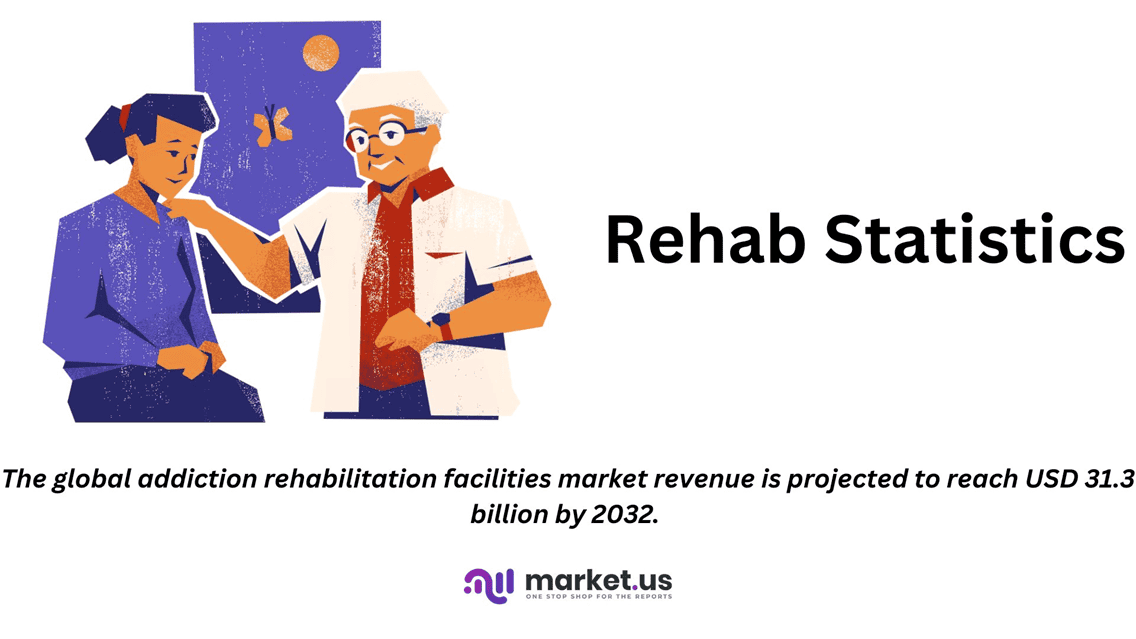
Editor’s Choice
- The highest recorded number of illegal drug consumers’ consumers was 296 million in 2021, accompanied by 39.5 million addicts.
- Between December 2017 and October 2018, the treatment methods for addicts in India varied depending on the type of substance dependency. Among alcohol dependents, 21% underwent hospitalization, while the majority, 79%, received other forms of treatment.
- In 2022, a total of 3,489 clients entered specialized drug treatment in Portugal, categorized by their primary drug of use. Cannabis was the most commonly reported drug, with 1,238 individuals entering treatment for cannabis use.
- The global addiction rehabilitation facilities market revenue is projected to reach USD 31.3 billion by 2032.
- In 2020, mental health hospital admissions per 100,000 population varied significantly across different regions of the world. Europe had the highest rate, with 275 admissions per 100,000 people, reflecting a more extensive use of mental health services.
- In 2022, the number of U.S. adults receiving mental health treatment surged to 55.8 million. Reflecting a growing demand for mental health services.
- The enacted U.S. federal drug control budget for FY 2024 stands at USD 43.6 billion. While the requested budget for FY 2025 is projected to increase to USD 44.5 billion.
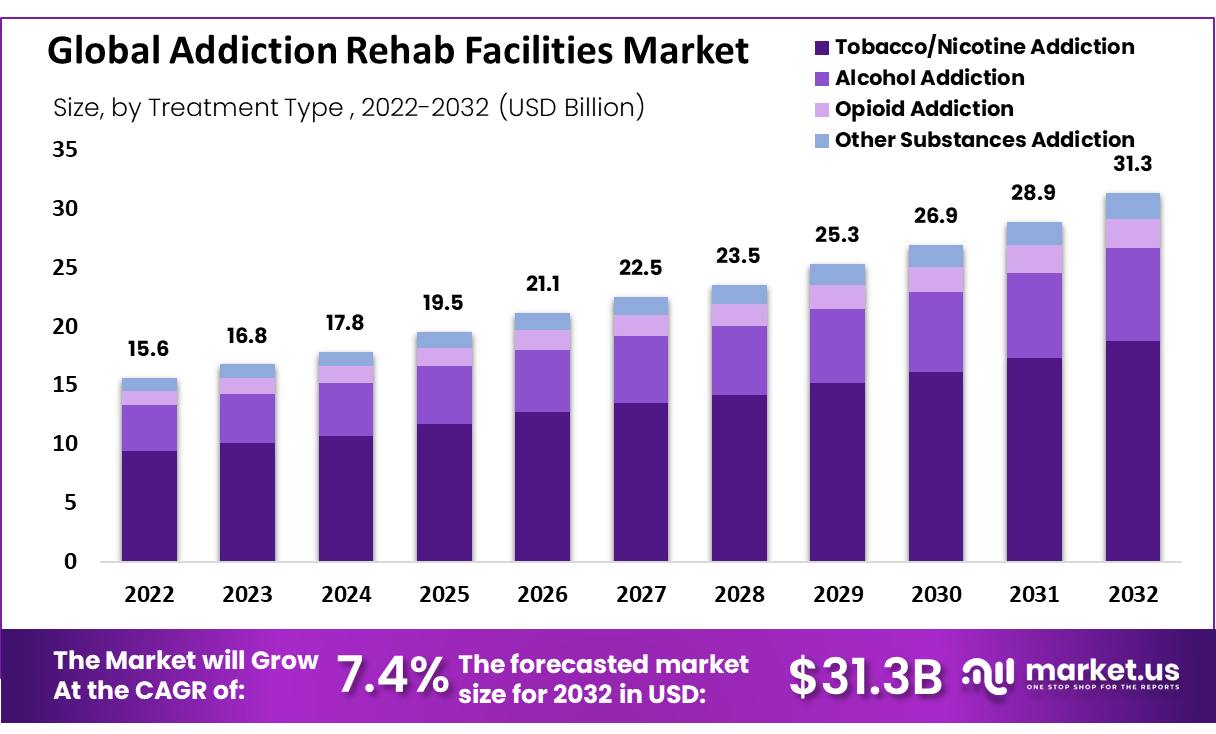
Addicts and Consumers of Illegal Drugs Worldwide by Rehab Statistics
- Between 2003 and 2021, the number of illegal drug consumers and addicts worldwide showed a consistent upward trend.
- In 2003, the global number of consumers was recorded at 200 million, with 25 million addicts.
- By 2005, the number of consumers had risen to 205 million. While the number of addicts remained steady at 25 million.
- Over the following years, the number of consumers steadily increased. Reaching 243 million by 2012, while the number of addicts saw a gradual rise to 27.4 million.
- In 2014, the global drug-consuming population rose to 247 million, with addicts reaching 28.7 million.
- By 2016, the number of consumers surged to 275 million, while the addict population rose to 30.5 million.
- The highest recorded number of consumers was 296 million in 2021, accompanied by 39.5 million addicts.
- The steady rise in both consumers and addicts reflects a significant global increase in illegal drug use over this period.
(Source: Statista)
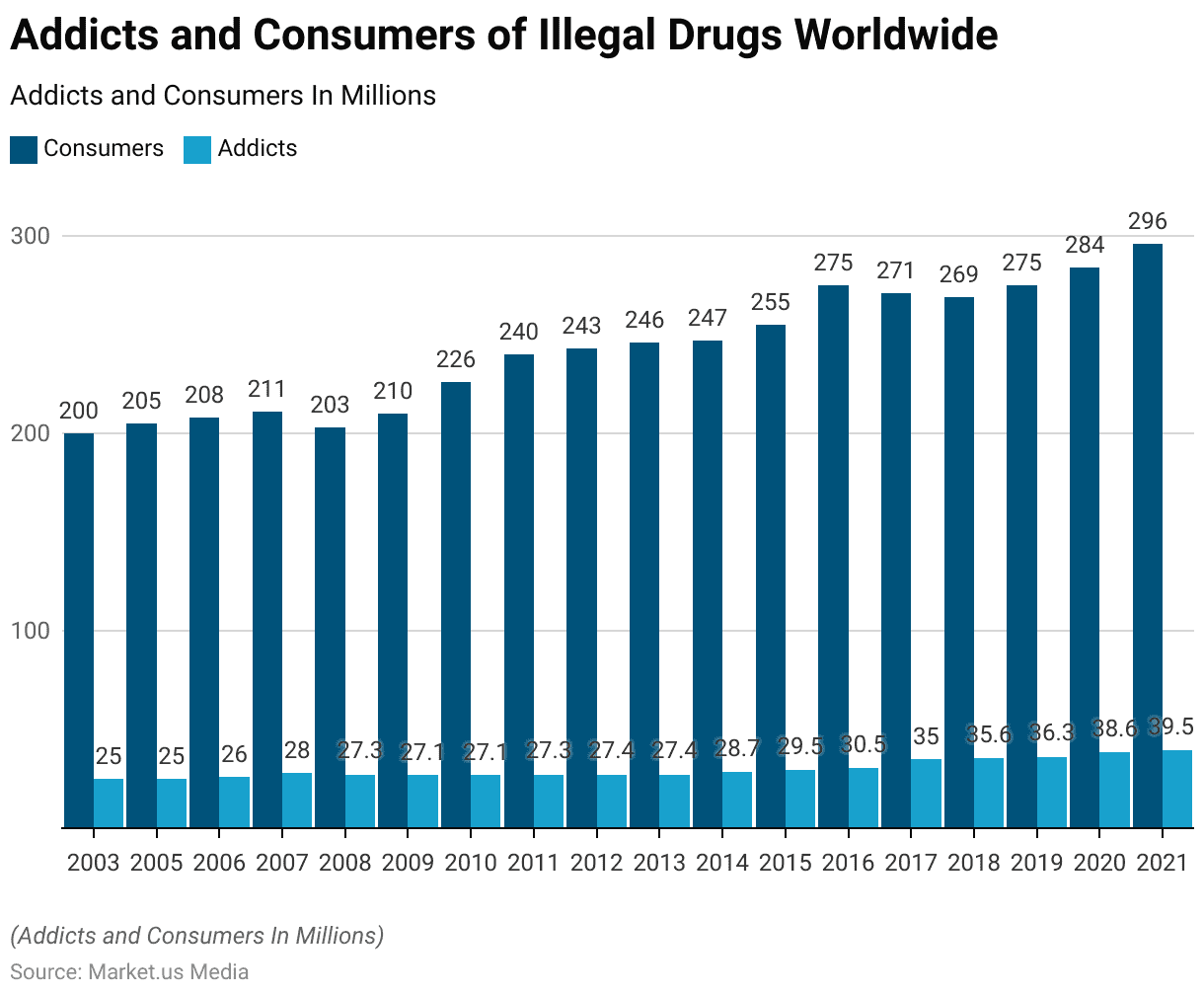
Global Illicit Drug Users – By Drug With Rehab Statistics
- In 2020, the global number of illicit drug users varied significantly by drug type, with cannabis being the most widely used.
- Estimates suggest that between 149 million and 265 million people used cannabis that year.
- Opioid users ranged from 37 million to 78 million. While cocaine users were estimated to be between 18 million and 26 million.
- Amphetamine use was recorded between 29 million and 41 million individuals.
- Ecstasy, though less prevalent, had an estimated user range of 9 million to 36 million.
- These figures highlight the global variation in illicit drug use by substance type.
(Source: Statista)
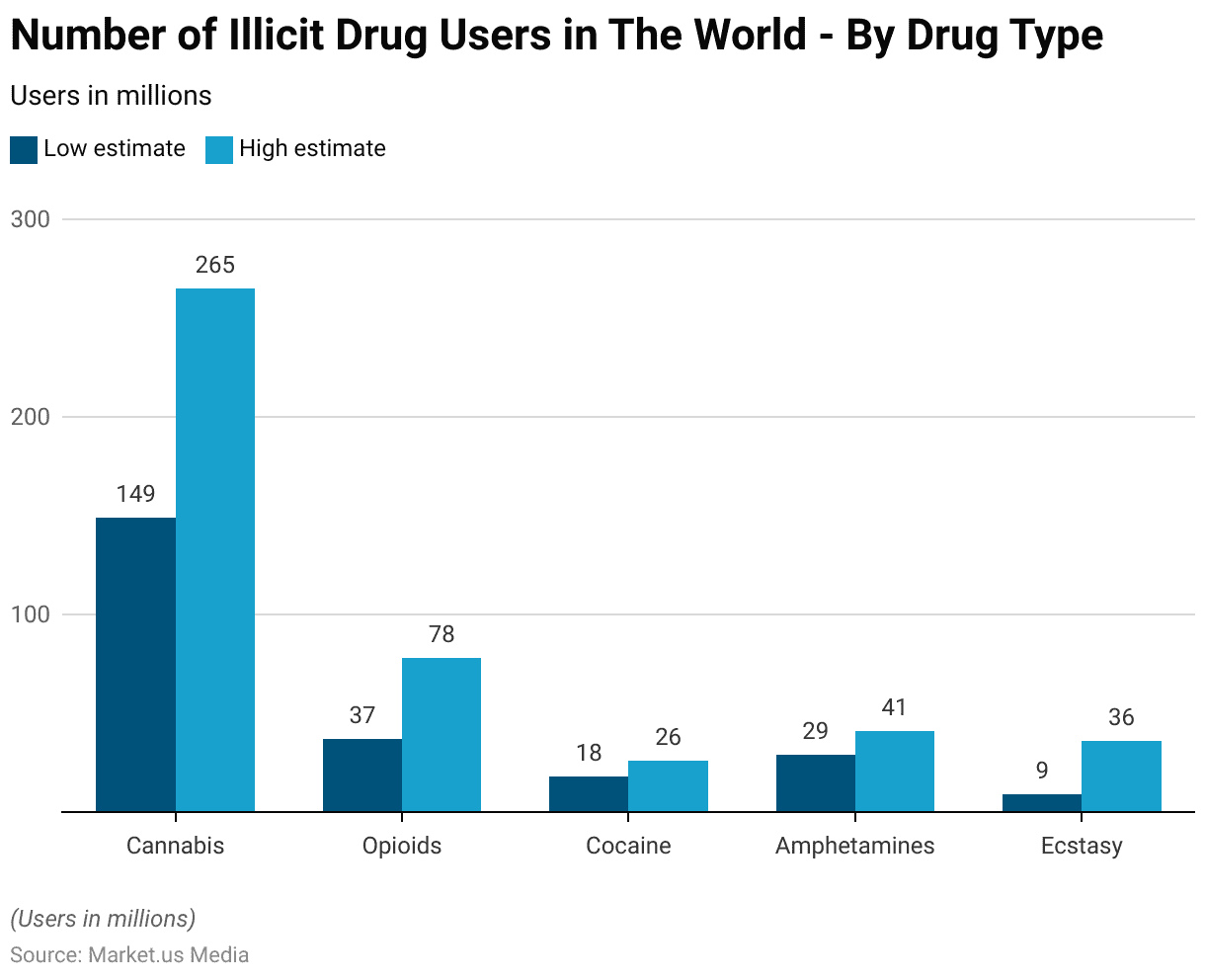
Cannabis Users Statistics
Number of Cannabis Users Worldwide – By Region with Rehab Statistics
- Between 2011 and 2021, the global number of cannabis users experienced fluctuations across different regions.
- In 2021, the worldwide estimate stood at 219 million. The same as in 2017 but lower than the peak of 237.67 million users in 2015.
- Asia, which recorded 87.11 million users in 2011, saw a decline to 61.99 million by 2021. This reflects a gradual decrease from its highest point of 89.38 million users in 2013.
- Africa also experienced a decrease in cannabis users, from 64.38 million in 2015 to 53.6 million in 2021.
- In contrast, the Americas showed a significant increase, rising from 50.64 million users in 2011 to 70.46 million by 2021.
- Europe saw relatively stable figures, with a slight decline from 31.71 million users in 2011 to 29.47 million in 2021.
- Meanwhile, Oceania maintained a fairly consistent number of users. With 3.45 million in 2021, slightly up from 2.95 million in 2017.
- Overall, while some regions saw declining trends, others, particularly the Americas, experienced notable growth in cannabis use over this period.
(Source: Statista)
Take advantage of our unbeatable offer - buy now!

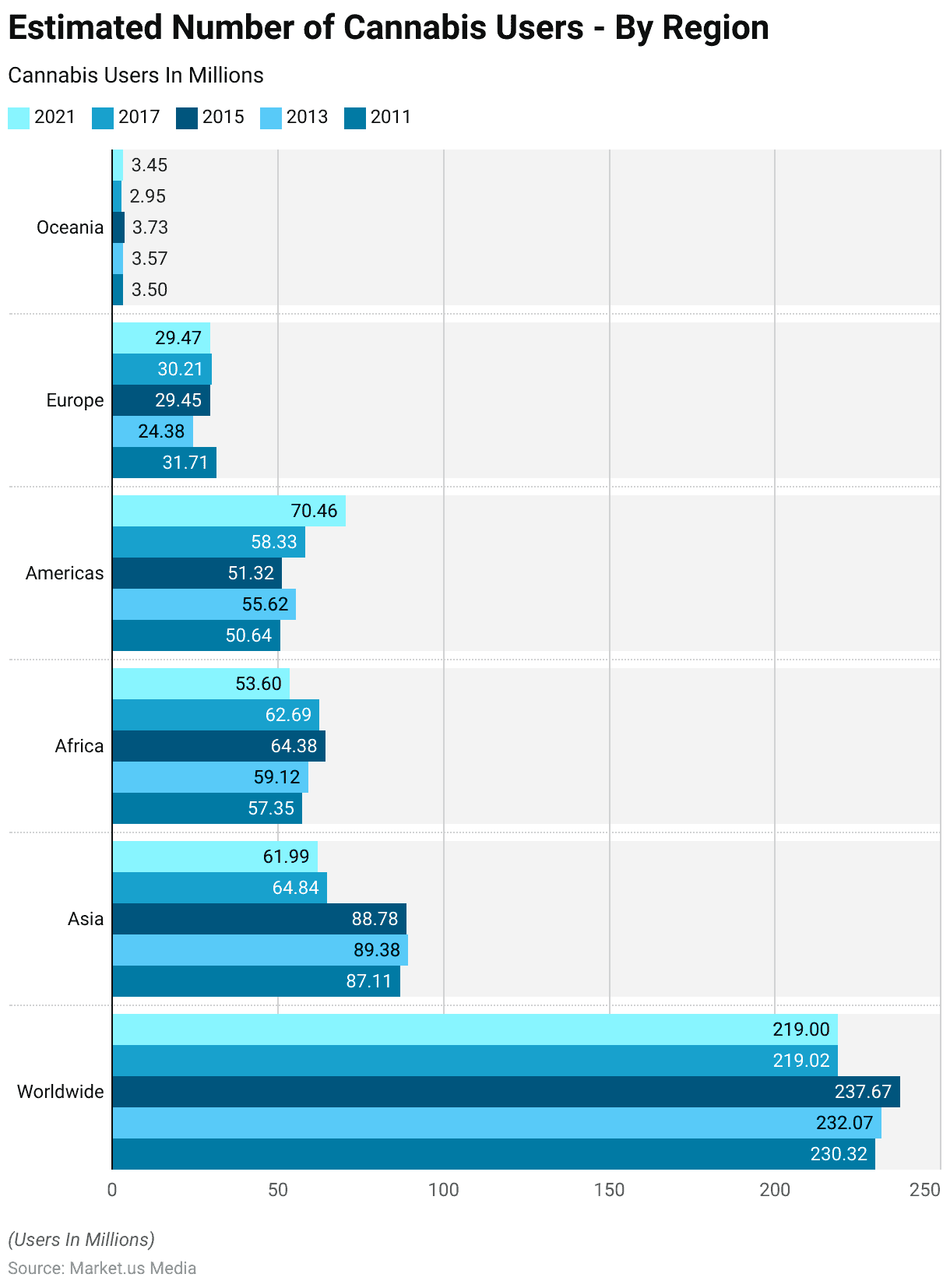
Opioid Users Statistics
Number of Opioid Users Worldwide – By Region with Rehab Statistics
- From 2015 to 2021, the global number of opioid users exhibited notable changes across regions.
- Worldwide, opioid use increased from 42.69 million users in 2015 to 60 million in 2021, with a peak of 78.26 million users in 2019.
- In Asia, the number of users saw significant growth. Rising from 17.34 million in 2015 to 34.29 million in 2021, reaching a high of 47.85 million in 2019.
- Africa also experienced an increase in opioid users, growing from 3.5 million in 2015 to 9.67 million in 2021, with the highest number recorded at 12.14 million in 2019.
- The Americas, however, showed a fluctuating trend, with opioid use peaking at 17.1 million in 2016 before gradually declining to 11.94 million in 2021.
- Europe’s opioid user population remained relatively stable, decreasing slightly from 4.85 million in 2015 to 3.79 million in 2021.
- In Oceania, the number of opioid users remained relatively consistent. With small fluctuations from 0.77 million in 2015 to 0.68 million in 2021.
- Overall, opioid use exhibited varying trends across different regions, with Asia and Africa showing substantial increases. While the Americas and Europe saw more moderate changes.
(Source: Statista)
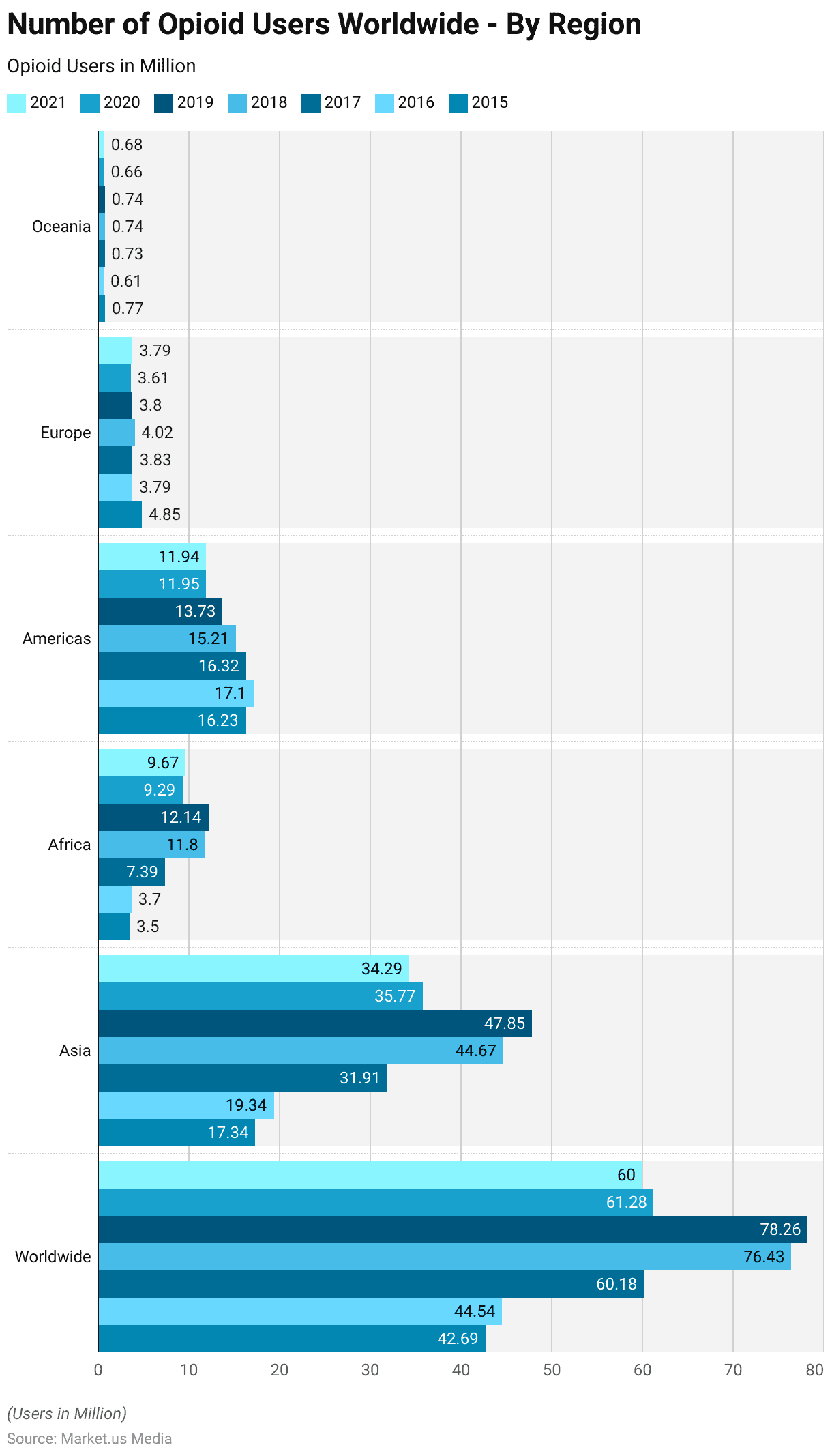
Amphetamine Users Statistics
Number of Amphetamine Users Worldwide – By Region
- Between 2012 and 2020, the global number of amphetamine users experienced significant shifts across various regions.
- Worldwide, the number of users decreased from 55.9 million in 2014 to 34.07 million in 2020, down from a peak of 55.24 million in 2016.
- Asia, which had the highest number of amphetamine users at 35.2 million in 2014. Saw a decline to 12.73 million by 2020.
- Africa also experienced a reduction, with 10.42 million users in 2016 dropping to 2.72 million by 2020.
- In contrast, the Americas saw a marked increase in amphetamine use. Rising from 7.6 million users in 2012 to 15.39 million in 2020.
- Europe maintained relatively stable figures, with 3.45 million users in 2016, declining slightly to 2.9 million in 2020.
- Oceania, however, saw consistent numbers throughout the period. Fluctuating slightly from 0.53 million users in 2012 to 0.33 million in 2020.
- These figures reflect a notable regional disparity in amphetamine use. Sharp declines in Asia and Africa contrasted with increasing usage in the Americas.
(Source: Statista)

Ecstasy Users Statistics
Number of Ecstasy Users Worldwide – By Region
- Between 2012 and 2021, the global number of ecstasy consumers experienced considerable fluctuations.
- Worldwide, the number of users decreased from 37.53 million in 2018 to 20 million in 2021, down from a peak of 32.34 million in 2016.
- In Asia, the number of ecstasy users saw a significant decline, from 21.14 million in 2016 to 10.19 million in 2021, after peaking at 20.86 million in 2018.
- Africa also experienced a sharp decrease in ecstasy consumption. Dropping from 8.03 million users in 2018 to 2.37 million in 2021.
- The Americas remained relatively stable, with minor fluctuations, seeing 3.53 million users in both 2021 and 2012.
- In Europe, ecstasy consumption showed a gradual decline from 4.74 million in 2016 to 3.53 million in 2021.
- Oceania’s ecstasy consumption remained low throughout the period, with numbers dropping from 0.72 million in 2012 to 0.61 million in 2021.
- These data suggest a global decline in ecstasy consumption. Particularly in Asia and Africa, while the Americas and Europe showed more stable trends over the years.
(Source: Statista)
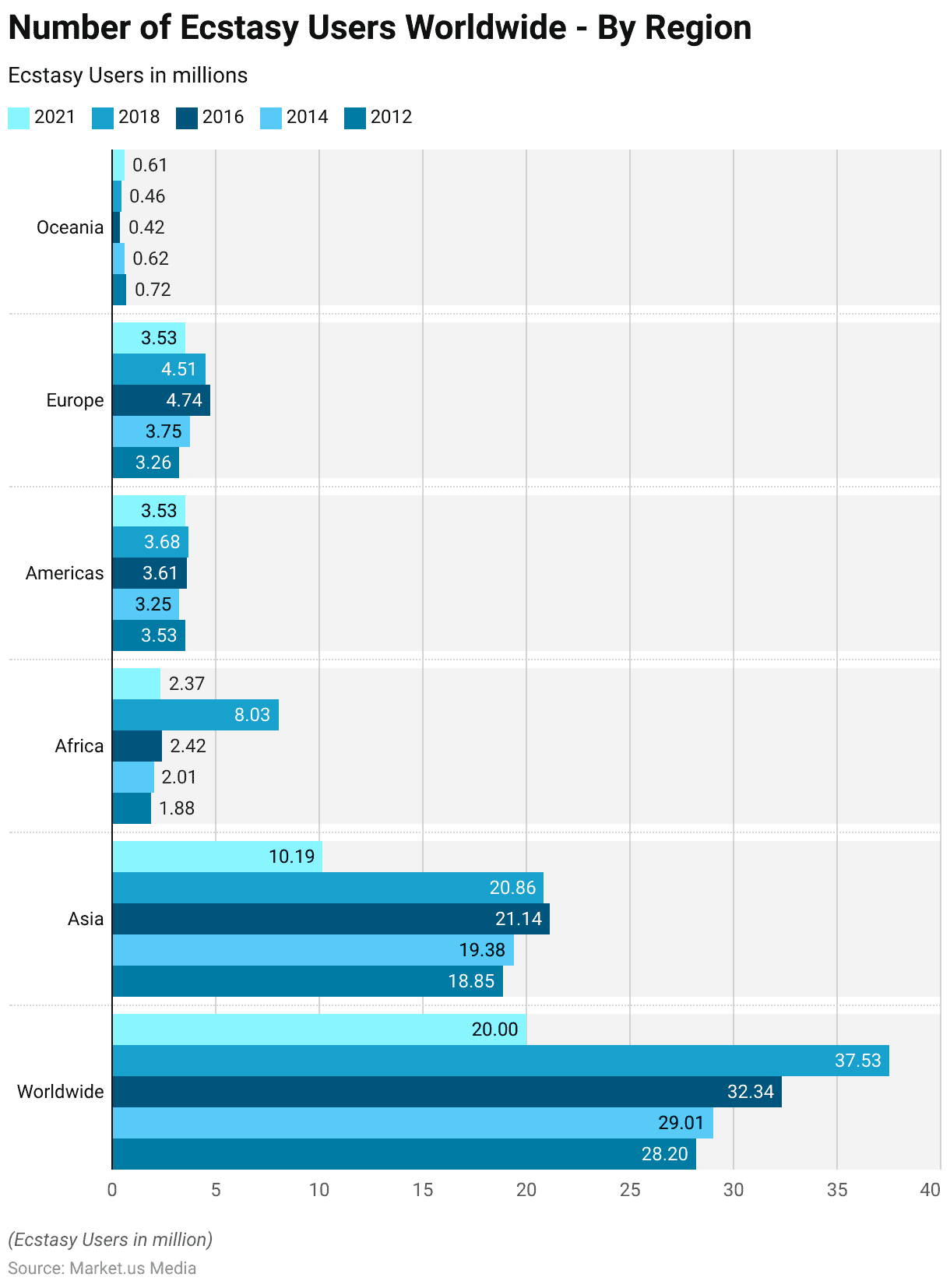
Substance Abuse Rehab Statistics
Type of Treatment Received by Substance Dependents
- Between December 2017 and October 2018, the treatment methods for addicts in India varied depending on the type of substance dependency.
- Among alcohol dependents, 21% underwent hospitalization, while the majority, 79%, received other forms of treatment.
- In contrast, drug dependents were more likely to be hospitalized, with 44% undergoing hospitalization and 56% receiving alternative treatments.
- These figures highlight the different treatment approaches used for alcohol and drug dependence in India during this period, with drug dependents being more frequently hospitalized compared to alcohol dependents.
(Source: Statista)
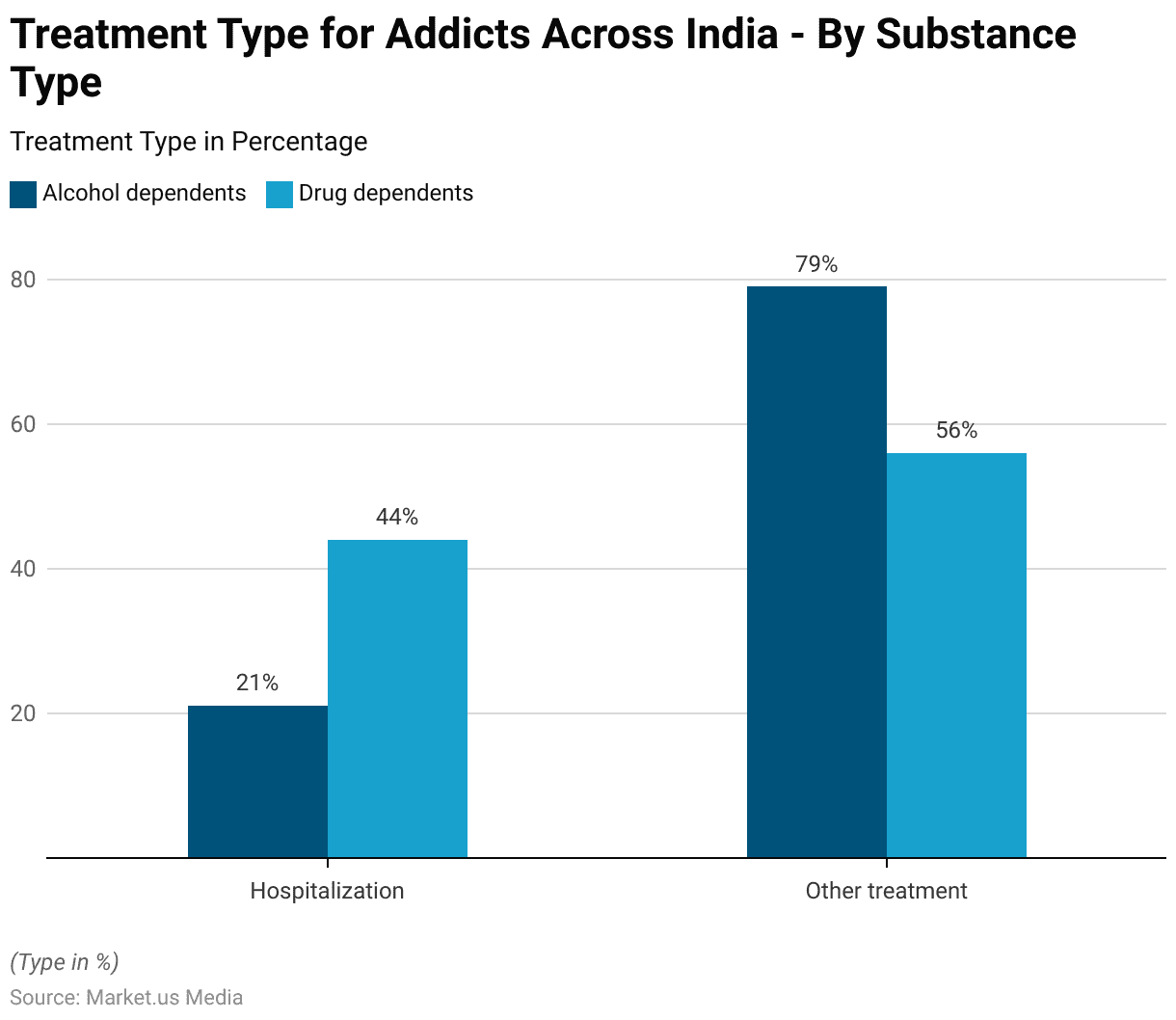
Facilities for Substance Abuse Treatment
- The total number of substance abuse treatment facilities in the United States exhibited fluctuations between 2003 and 2022.
- In 2003, there were 13,623 facilities, a figure that slightly declined over the next few years, reaching 13,371 by 2005.
- However, by 2006, the number of facilities increased to 13,771, followed by minor variations in the subsequent years.
- The number of facilities surpassed 14,000 in 2012, with 14,311 facilities reported, and this trend continued, peaking at 14,399 in 2016.
- A slight decrease was noted in 2017, with 13,585 facilities, but by 2018, the numbers began to rise again, reaching 14,809.
- This upward trend continued through 2019 and 2020, with 16,066 facilities in the latter year.
- A significant surge occurred in 2021, where the number of facilities reached 18,615 before declining slightly to 17,353 in 2022.
- These numbers reflect the dynamic nature of the availability of substance abuse treatment facilities in the U.S. over this period.
(Source: Statista)

The U.S. Substance Abuse Treatment Facilities in – By State
- As of 2020, the United States has a varied distribution of substance abuse treatment facilities across the states.
- California had the highest number of facilities, with 1,734, followed by New York with 894 and Florida with 712.
- Other states with a significant number of facilities include Illinois (713), Ohio (619), Pennsylvania (604), and North Carolina (611).
- Mid-sized states such as Texas, Michigan, and Kentucky had 509, 455, and 477 facilities, respectively.
- In contrast, smaller states like Delaware, Vermont, and Rhode Island had fewer, with Delaware having 49, Vermont 52, and Rhode Island 63.
- Wyoming had the fewest facilities, with only 60.
- The District of Columbia, despite its smaller size, had 28 facilities, while Puerto Rico had 101.
- States such as Arizona, Colorado, and Massachusetts had between 400 and 500 facilities each, with Arizona at 447, Colorado at 393, and Massachusetts at 440.
- In contrast, states like South Dakota and North Dakota had fewer facilities, with 58 and 87, respectively.
- This distribution reflects regional differences in the availability of substance abuse treatment services, with larger states generally having more facilities to meet the needs of their populations.
(Source: Statista)
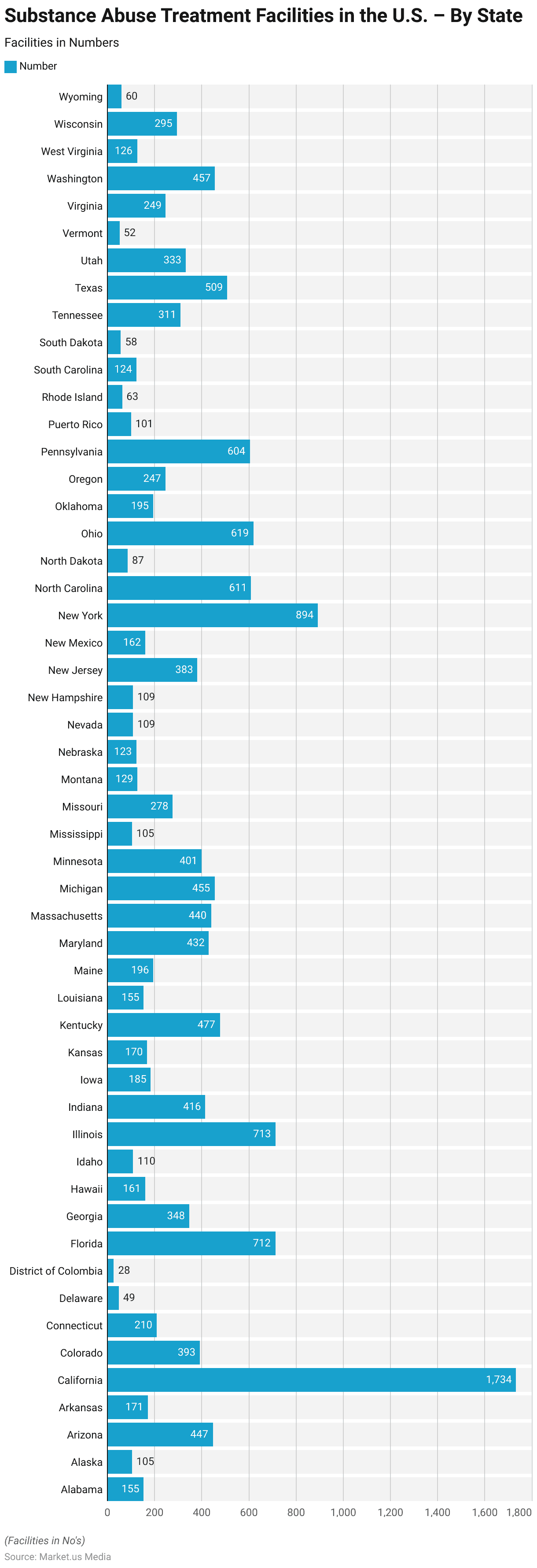
Substance Abuse Treatment Facilities – By Operation Type
- As of 2022, the United States had a total of 17,087 substance abuse treatment facilities, categorized by their operation type.
- The majority of these facilities were operated by private organizations, with 7,170 facilities being private non-profit and 6,311 being private for-profit.
- Government-operated facilities made up a smaller portion, with 598 facilities run by local, county, or community governments and 297 operated by state governments.
- Tribal governments were responsible for 210 facilities, while the federal government operated 252 facilities.
- Among federal operations, 184 were run by the Department of Veterans Affairs, 40 by the Department of Defense, 17 by the Indian Health Service, and eight by other federal government entities.
- This breakdown highlights the predominance of private institutions in providing substance abuse treatment, supplemented by various government-operated facilities.
(Source: Statista)
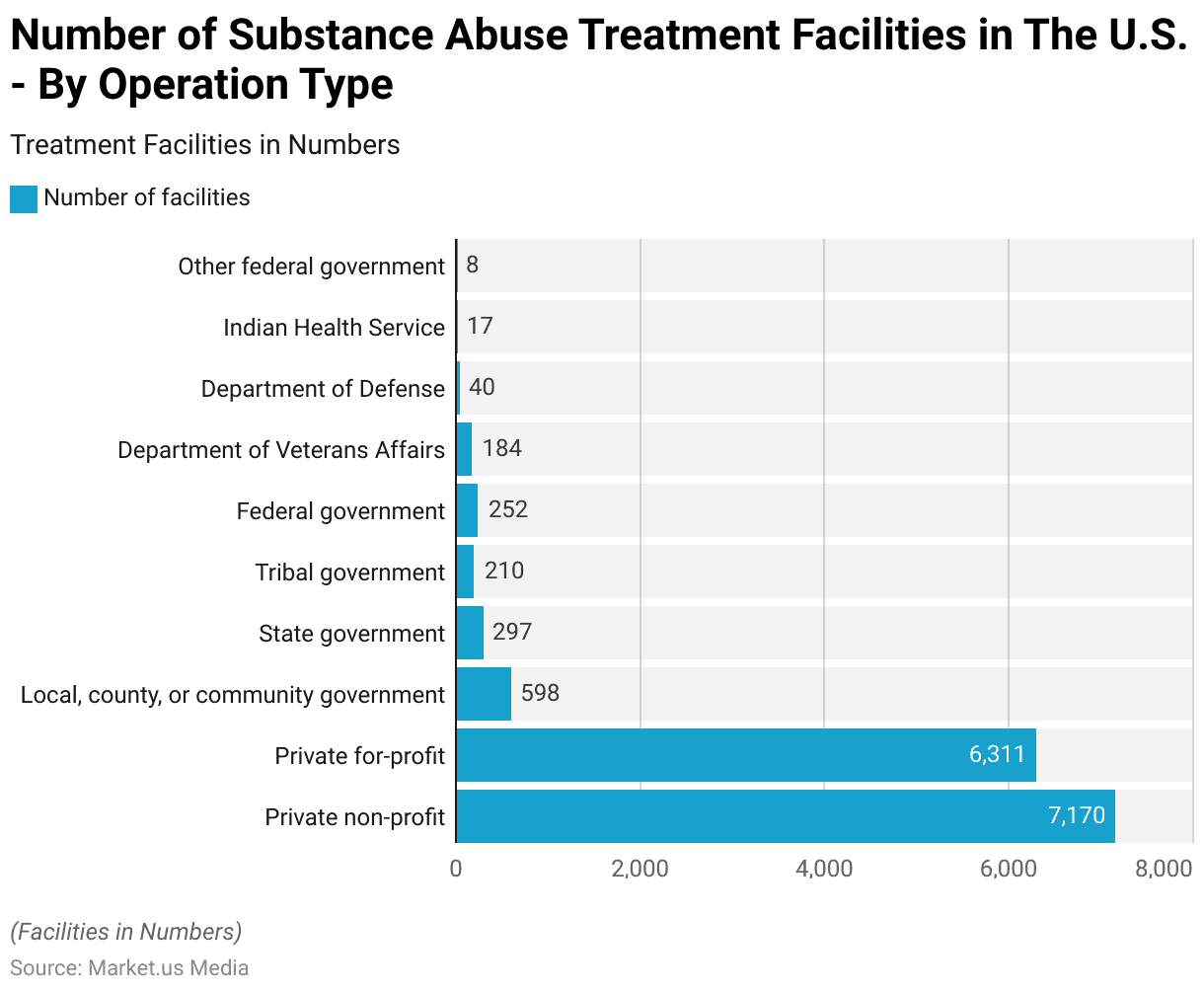
Facilities for Substance Abuse Treatment – By Operation Type and Abuse Problem
- In 2019, the number of substance abuse treatment facilities in the U.S. varied by operation type and the specific abuse problems they addressed.
- Private non-profit organizations were the most prevalent, with 3,724 facilities treating clients with co-occurring mental and substance abuse disorders, 3,266 treating alcohol abuse only, 3,597 treating drug abuse only, and 3,802 treating both alcohol and drug abuse.
- Private for-profit organizations followed, with 2,991 facilities treating co-occurring disorders, 2,369 addressing alcohol abuse only, 2,985 treating drug abuse only, and 2,832 treating both alcohol and drug abuse.
- Among government-operated facilities, local, county, or community governments operated 306 facilities for co-occurring disorders, 278 for alcohol abuse only, 299 for drug abuse only, and 320 for both.
- State governments managed smaller numbers, with 147 facilities for co-occurring disorders, 115 for alcohol abuse, 135 for drug abuse, and 143 for both. The federal government operated 167 facilities for co-occurring disorders, 165 for alcohol abuse, 150 for drug abuse, and 156 for both.
- Within the federal system, the Department of Veterans Affairs had 126 facilities treating co-occurring disorders, 120 for alcohol abuse, 122 for drug abuse, and 123 for both.
- The Department of Defense operated 23 facilities for co-occurring disorders, 29 for alcohol abuse, 12 for drug abuse, and 18 for both. The Indian Health Service had 13 facilities for co-occurring disorders, 12 for alcohol abuse, 11 for drug abuse, and 12 for both.
- Additionally, tribal governments operated 132 facilities for co-occurring disorders, 117 for alcohol abuse, 110 for drug abuse, and 136 for both. Other federal government entities managed a smaller number of facilities across these categories.
- These figures illustrate the diverse range of facilities in the U.S. addressing various substance abuse issues across different operational sectors.
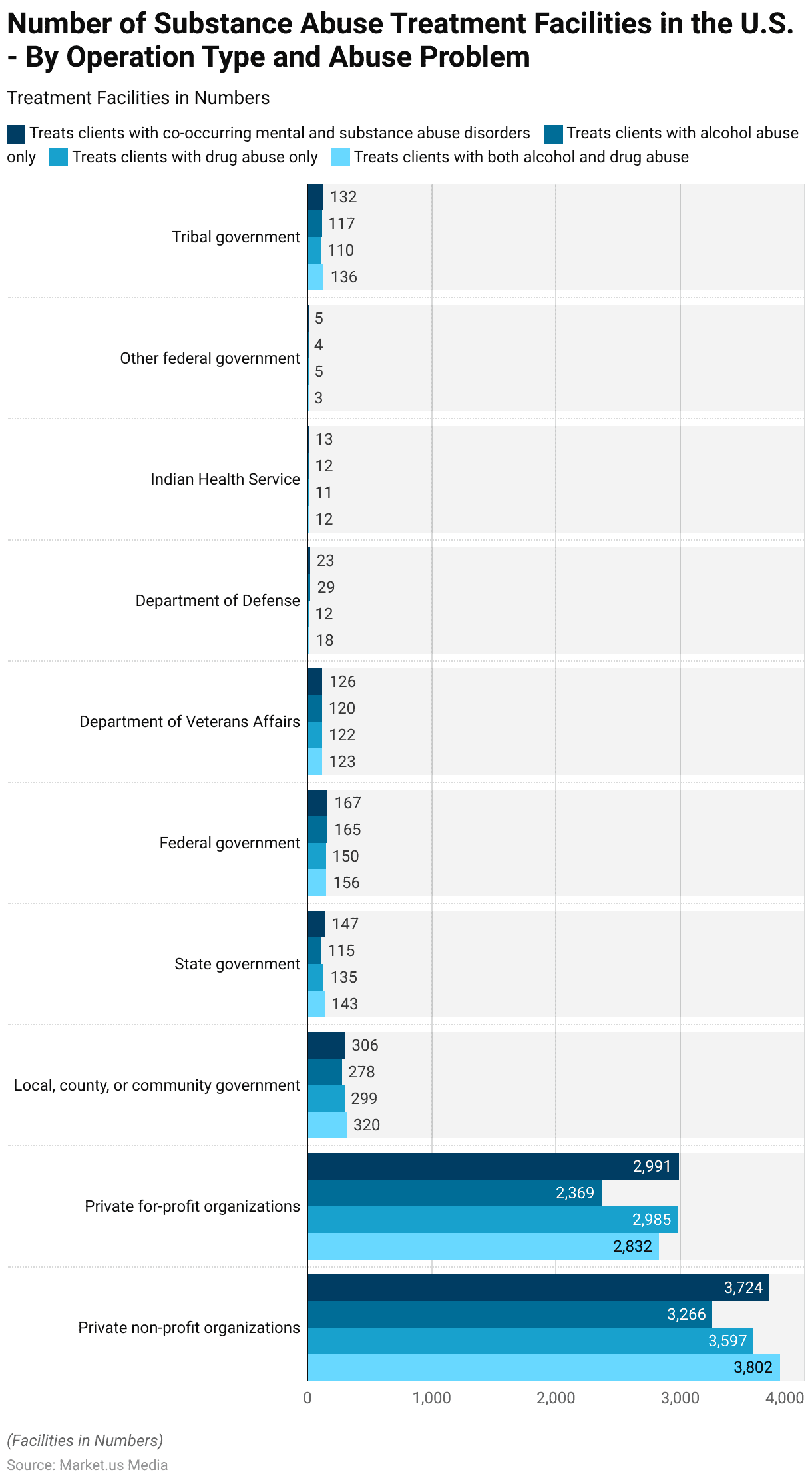
Substance Abuse Treatment Facilities – By Facility Size
- In 2020, substance abuse treatment facilities in the U.S. varied in size based on the number of clients they served.
- Facilities with fewer than 15 clients were the most common, totaling 3,719.
- Facilities serving between 15 and 29 clients amounted to 2,138, while those accommodating 30 to 59 clients numbered 1,878.
- Larger facilities, with capacities of 60 to 119 clients, accounted for 1,495 treatment centers.
- The largest facilities, serving 120 or more clients, totaled 2,439.
- These figures reflect the range of treatment facility sizes across the U.S., with a significant number of both small and large centers providing services.
(Source: Statista)

Substance Abuse Treatment Facilities – By Payment Option
- As of 2020, substance abuse treatment facilities in the U.S. offered various payment options, with cash or self-payment being accepted by 90.4% of facilities, making it the most common form of payment.
- Private health insurance was accepted by 74.4% of facilities, while 70.7% accepted Medicaid.
- State-financed health insurance was available at 49.5% of facilities, and 42% accepted Medicare.
- Additionally, 39% of facilities accepted federal military insurance, while only 12.5% of facilities were funded by the Indian Health Service (IHS), Tribal, or Urban Indian health programs.
- This distribution highlights the widespread acceptance of multiple payment methods across treatment facilities in the U.S.
(Source: Statista)
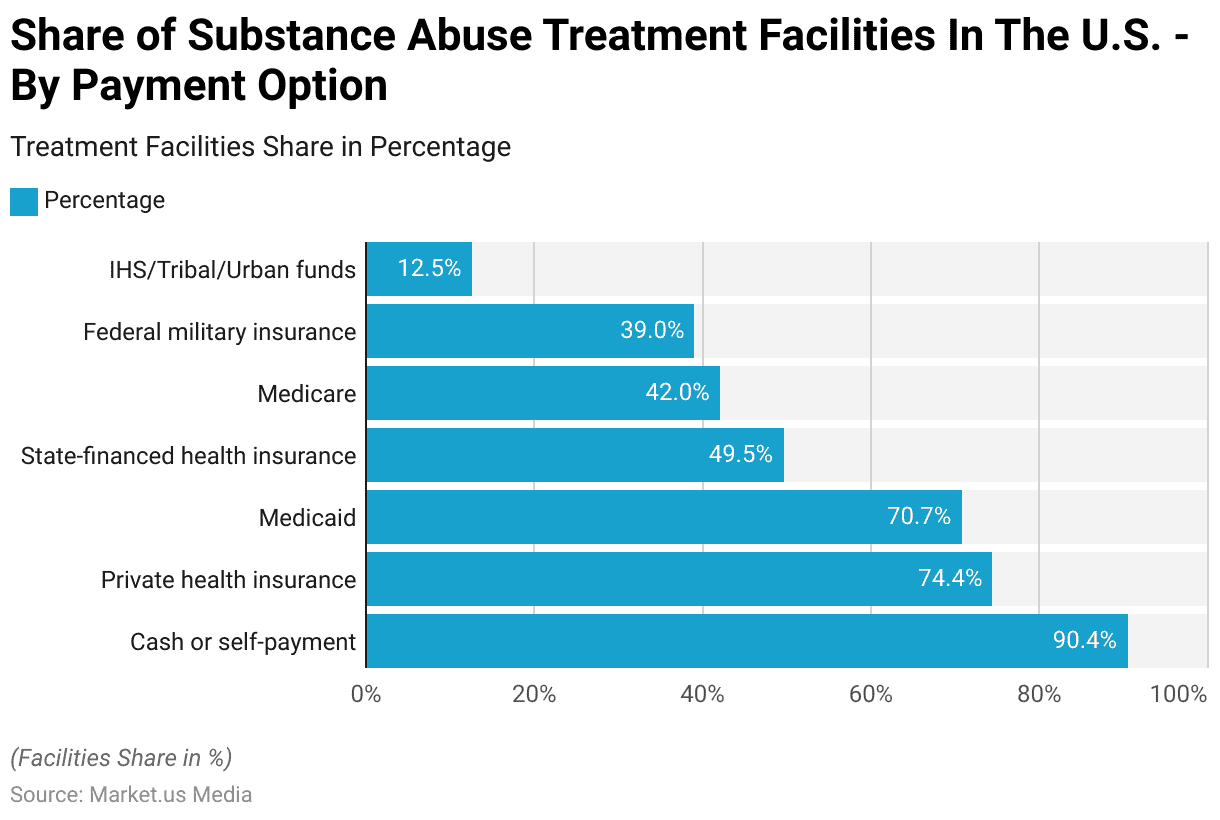
Drug Rehab Statistics
Individuals Treated for Drug Addiction – By Consumption Method
- In 2022, a significant number of individuals were treated for drug addiction in public facilities in Italy, categorized by their method of consumption.
- The most common method was smoking or inhaling, with 50,424 patients, followed by 36,617 individuals who consumed drugs via injection.
- Nineteen thousand eight hundred sixty-one individuals reported snorting, while 15,567 patients had an unknown method of consumption.
- Oral consumption accounted for 3,085 patients, and 2,412 individuals used other methods of intake.
- Additionally, 776 individuals reported using diverse ways of consumption, while 517 patients were categorized as not applicable in terms of consumption method.
- These figures indicate a wide range of drug consumption behaviors among those receiving treatment in Italy’s public facilities.
(Source: Statista)
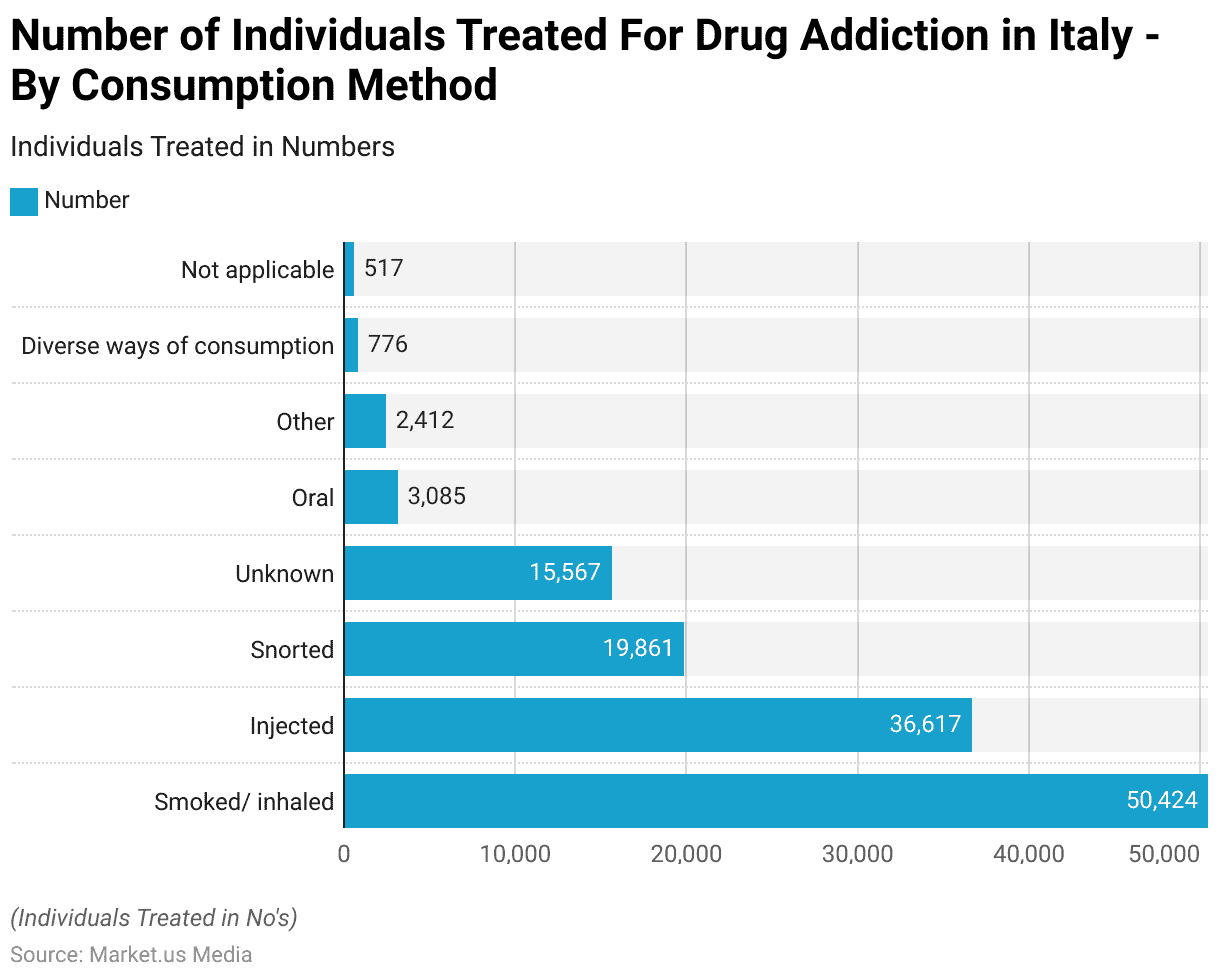
Individuals Treated in Public Drug Addiction Assistance Centers
- In 2022, public drug addiction assistance centers in Italy treated individuals across various regions, with significant regional differences in the number of patients.
- Lombardy had the highest number of individuals in treatment, with 23,161 patients. Followed by Piedmont with 11,971, and Lazio with 11,767 individuals.
- Veneto and Tuscany also had substantial numbers, with 11,105 and 10,265 individuals, respectively.
- Emilia-Romagna (9,139) and Apulia (9,059) were similarly notable, while Campania treated 8,462 individuals.
- Sicily accounted for 6,648 individuals in treatment, and smaller regions such as Marche (4,962), Liguria (3,969), and Sardinia (3,329) followed.
- Further down the list, Abruzzo treated 3,241 individuals, while Calabria had 3,090 in treatment.
- Umbria (2,097) and Basilicata (1,176) had lower figures, and the Autonomous Provinces of Bozen and Trento treated 1,039 and 1,020 individuals, respectively.
- Fruili-Venezia Giulia treated 822 individuals, Molise had 764 patients, and Aosta Valley had the fewest, with 279 individuals.
- This regional data highlights the distribution of drug addiction treatment across Italy, with the northern regions showing higher numbers of individuals in treatment.
(Source: Statista)
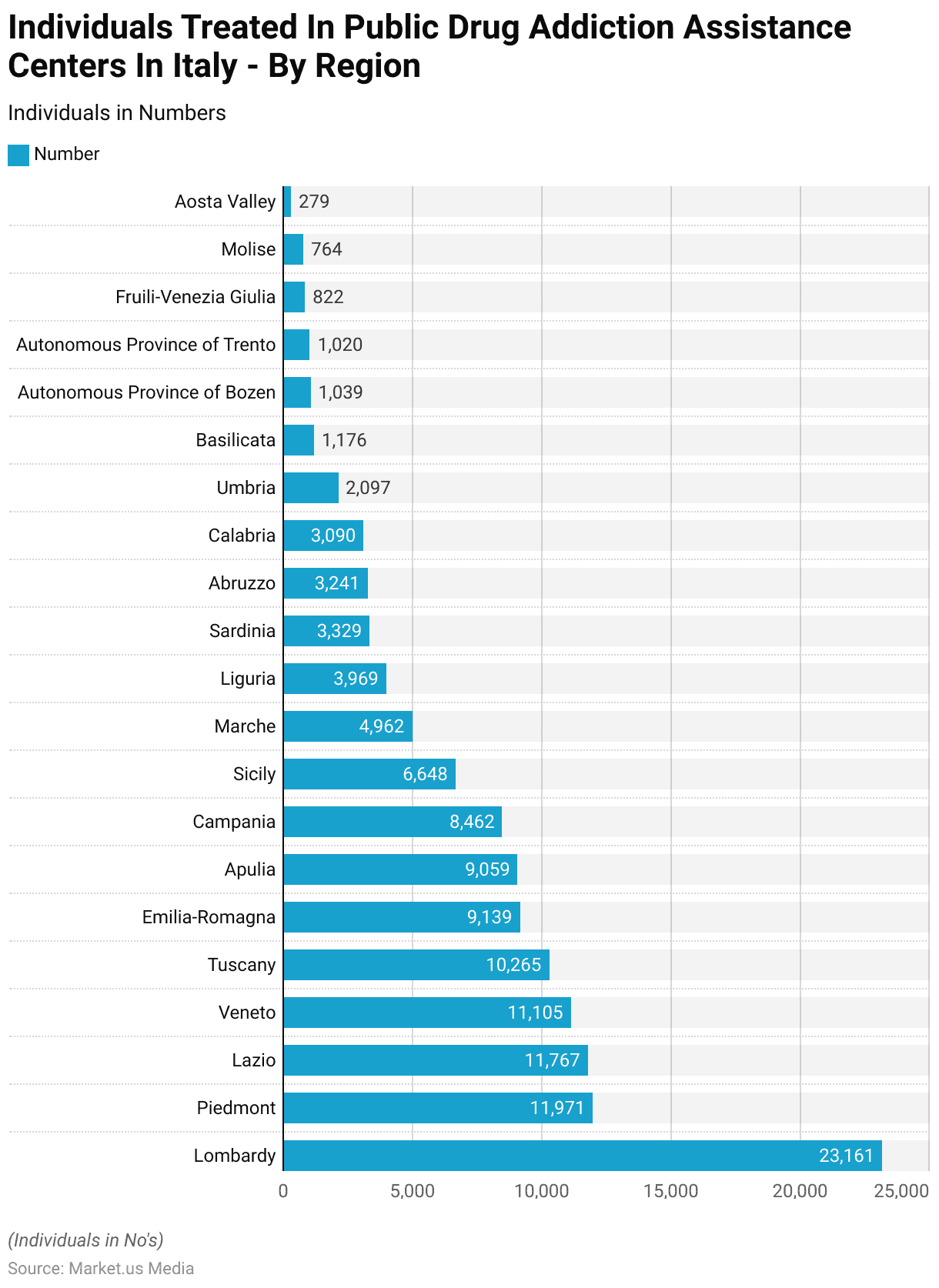
Drug and Alcohol Use Treatment Among Students
- Between the 2010-2011 and 2022-2023 academic years, the percentage of U.S. college students receiving mental health services and receiving treatment for drug and alcohol use consistently declined.
- In 2010-2011, 4.9% of students were accessing these services, but this figure dropped steadily over the years, reaching 4.6% in 2011-2012 and 4.4% in 2012-2013.
- By the 2014-2015 academic year, the percentage had decreased to 3.9%, continuing the downward trend to 3.1% by 2016-2017.
- This decline persisted, with 2.4% of students receiving these services in 2018-2019.
- The lowest percentages were recorded in the years following the onset of the COVID-19 pandemic, with 1.8% in 2020-2021, 1.7% in 2021-2022, and a slight increase back to 1.8% in 2022-2023.
- These figures reflect a gradual reduction in the proportion of college students accessing mental health and substance use treatment services over this period.
(Source: Statista)
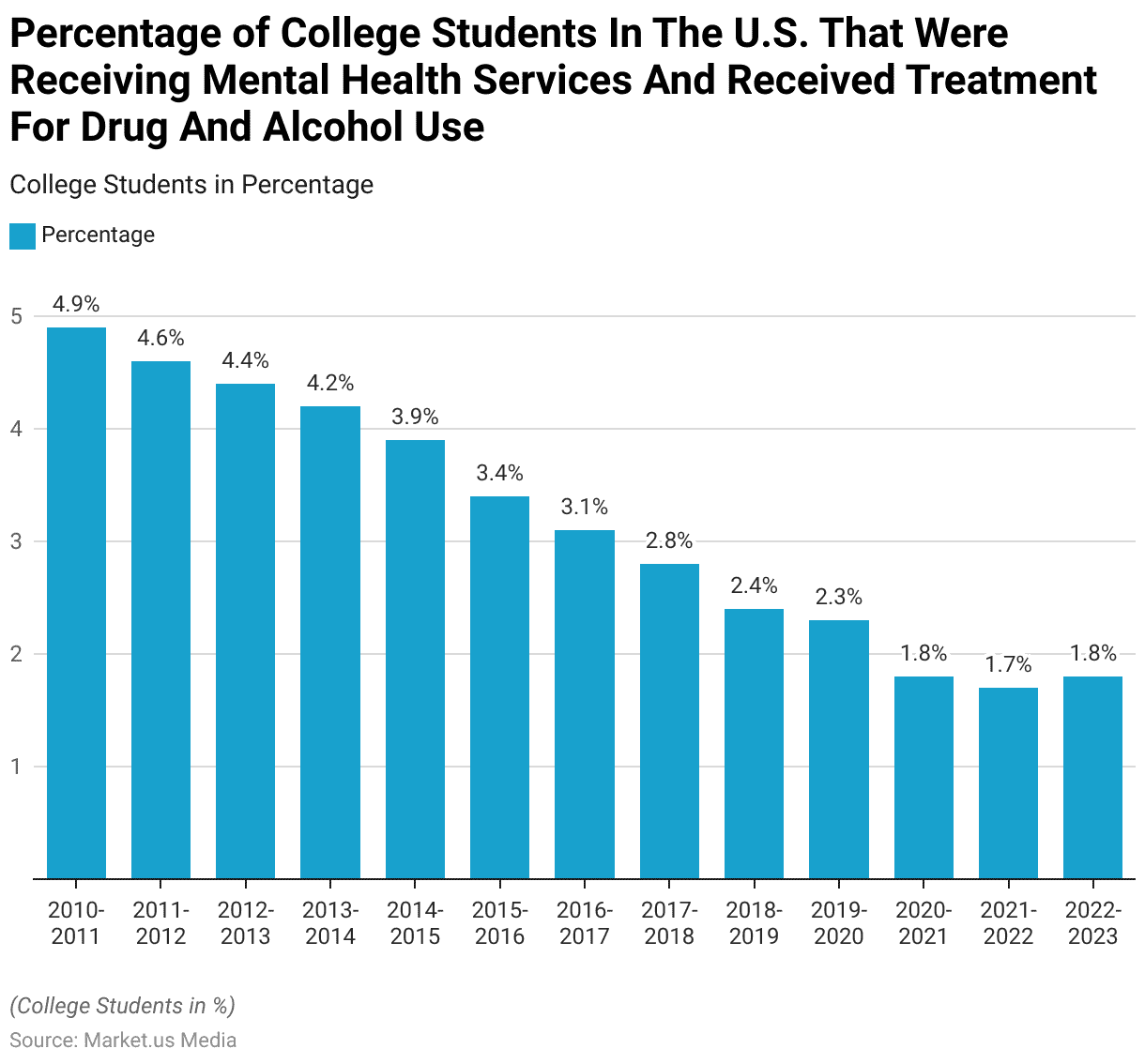
Drug Users Entering Treatment – By Primary Drug
- In 2022, a total of 3,489 clients entered specialized drug treatment in Portugal, categorized by their primary drug of use.
- Cannabis was the most commonly reported drug, with 1,238 individuals entering treatment for cannabis use.
- This was followed closely by opioids, with 1,183 clients seeking treatment for opioid dependence.
- Cocaine was the third most prevalent substance, with 922 individuals entering treatment.
- Other substances accounted for 59 treatment entrants, while 43 clients sought help for stimulant use.
- Additionally, 40 individuals entered treatment for issues related to hypnotics and sedatives, and four clients were treated for hallucinogen use.
- These figures highlight the varied nature of drug dependence among those seeking specialized treatment in Portugal.
(Source: Statista)

In-patient Drug Rehab Completers Statistics
- In 2018, several drug rehabilitation centers in the Philippines recorded various numbers of in-patient rehabilitation completers.
- The facility in Bicutan, Taguig, had the highest number of completers, with 3.16 hundred individuals completing rehabilitation.
- The rehabilitation centers in Pilar, Bataan, and Nueva Ecija followed with 1.08 hundred completers.
- The Tagaytay, Rizal center recorded 0.61 hundred completers, while Dagupan, Pangasinan had 0.47 hundred.
- The center in Cagayan de Oro saw 0.34 hundred completers, and Argao, Cebu had 0.27 hundred.
- Facilities in Camarines Sur and Albay recorded 0.26 hundred completers, and the Surigao center had 0.13 hundred.
- The centers in Pototan, Iloilo, and Baguio, Benguet had the fewest completers, with 0.12 hundred and 0.06 hundred, respectively.
- These numbers reflect the distribution of rehabilitation success across various regions in the Philippines.
(Source: Statista)

People Treated in Drug De-Addiction Centers
- Between the financial year (FY) 2016 and FY 2021, the number of people treated in drug addiction centers in India fluctuated significantly.
- In FY 2016, a total of 146.12 thousand individuals received treatment, marking the highest number during this period.
- The following year, FY 2017, saw a decrease to 114.76 thousand individuals. This decline continued into FY 2018, with 100.74 thousand people treated.
- The downward trend persisted into FY 2019, where only 77.48 thousand individuals received treatment, the lowest figure in this period.
- However, in FY 2020, the number rose again to 93.36 thousand, and by FY 2021, the number increased further to 128.57 thousand, reflecting a recovery in the number of people treated for drug addiction.
- These fluctuations highlight changes in the demand and provision of de-addiction services over these five years.
(Source: Statista)
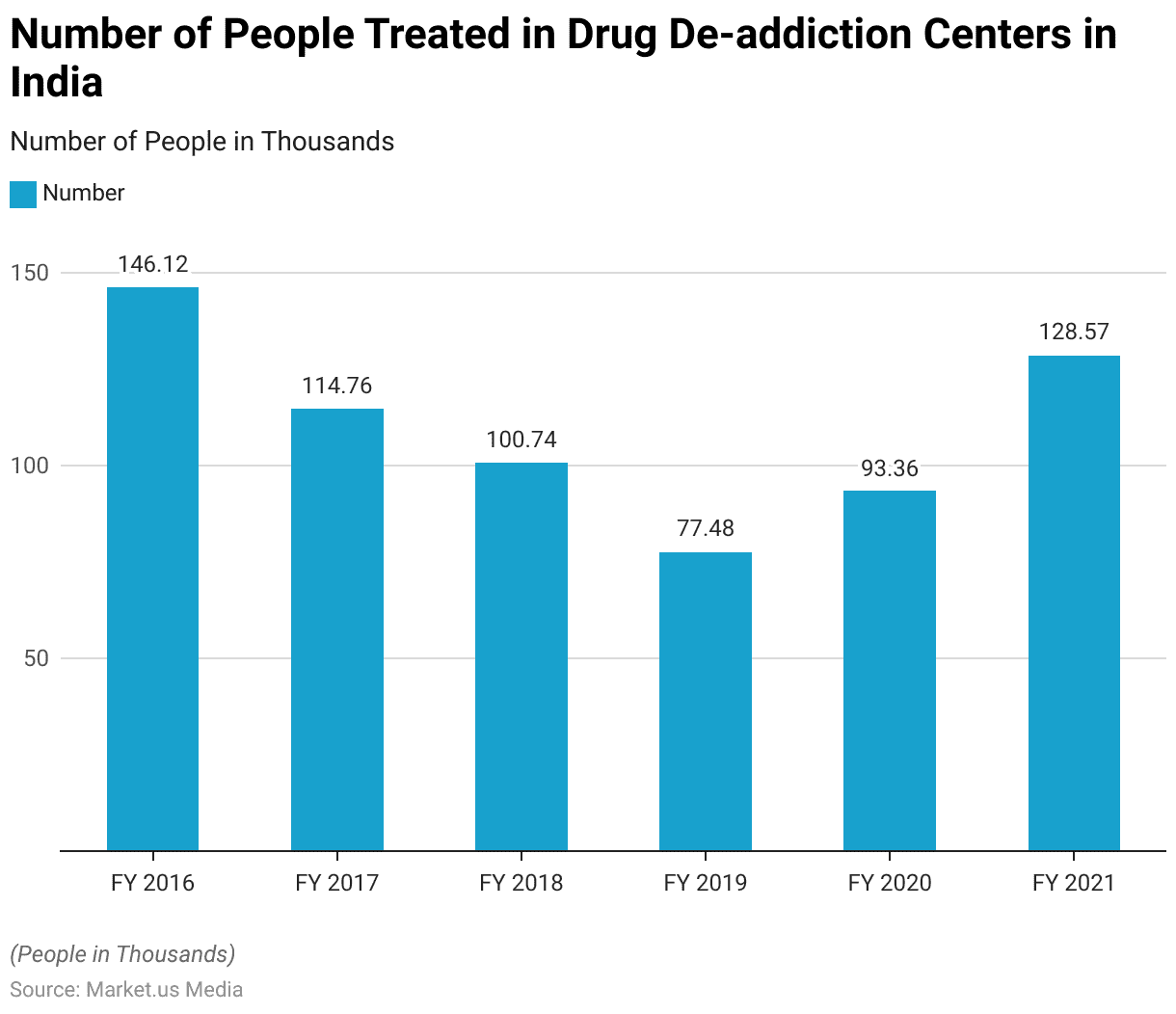
Demographic Insights
Rehab Statistics By Age
- In 2022, public facilities in Italy treated a diverse range of individuals for drug addiction, categorized by age.
- The age group with the highest number of patients was those between 45 and 49 years old, with 19,146 individuals, closely followed by the 50-54 age group, with 19,142 patients.
- The 40-44 age group also had a significant number of individuals in treatment, totaling 18,199.
- Those aged 35-39 accounted for 16,214 patients, while the 55-59 age group had 15,128 individuals receiving treatment.
- Younger age groups, including 30-34 and 25-29, had 13,493 and 9,952 individuals in treatment, respectively.
- Among younger adults, 6,191 individuals were in the 20-24 age group, and 2,282 patients were aged 15-19.
- A small number of individuals, 12 in total, were under the age of 15.
- Older populations also sought treatment, with 6,855 individuals in the 60-64 age group and 2,645 individuals aged 65 and above.
- These figures illustrate the wide age range of those receiving drug addiction treatment in Italy’s public facilities.
(Source: Statista)
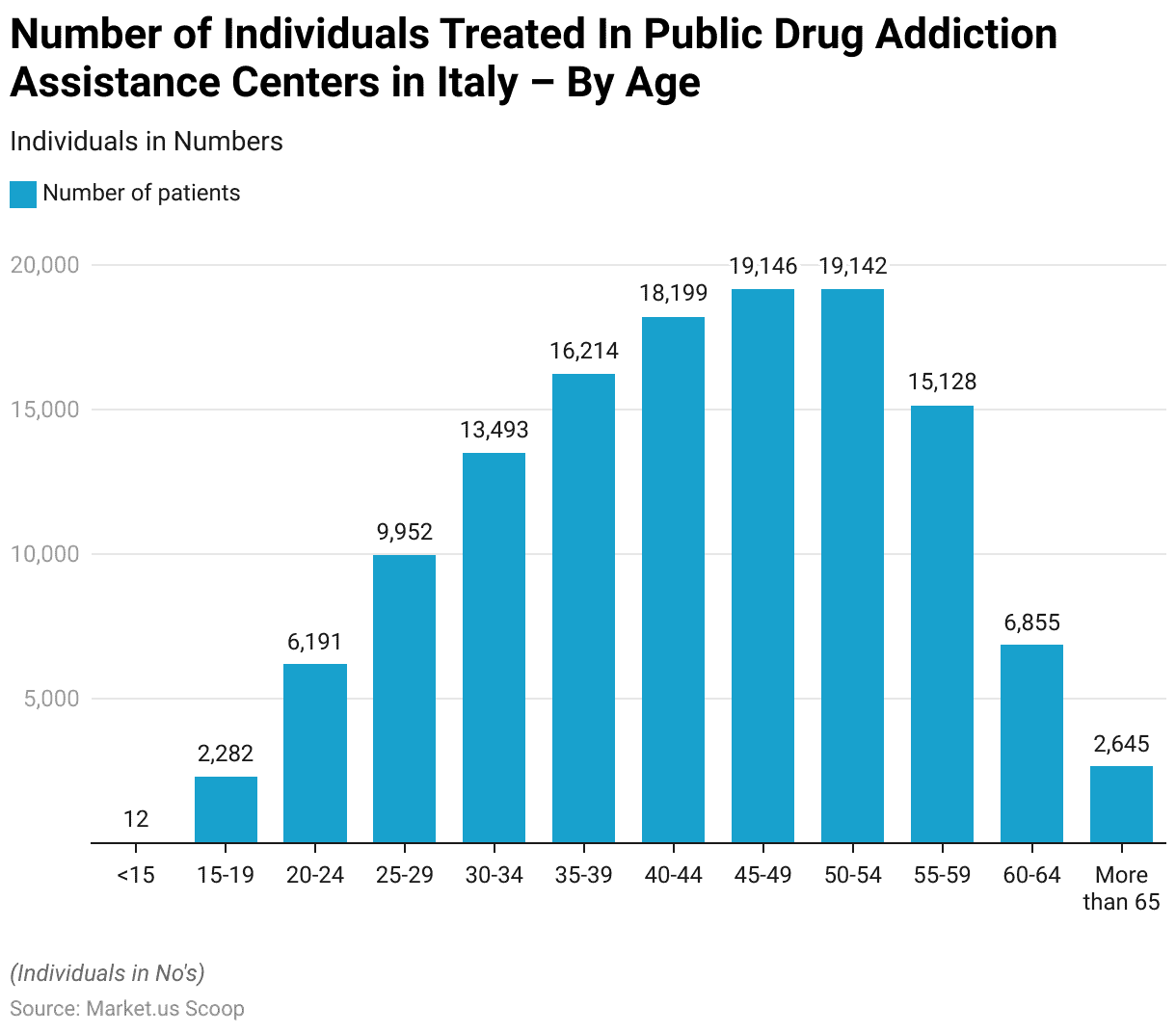
Rehab Statistics By Gender
- In 2021/22, a significant number of adults in England received treatment for substance misuse, with notable differences in gender across various substance groups.
- The majority of individuals in treatment were male, particularly for opiate misuse, with 101,822 males receiving treatment compared to 38,736 females.
- For non-opiate misuse, 19,821 males and 9,761 females sought treatment.
- Additionally, for those misusing both non-opiates and alcohol, 24,079 males and 10,299 females were treated.
- Alcohol-only misuse also saw a substantial number of individuals in treatment, with 49,358 males and 35,339 females.
- These figures indicate a higher prevalence of males in treatment for substance misuse across all categories, though females also represented a significant portion, particularly for alcohol-related issues.
(Source: Statista)

Addiction Rehab Facilities Market Statistics
Global Addiction Rehab Facilities Market Size Statistics
- The global addiction rehabilitation facilities market has been experiencing steady growth and is projected to continue this upward trend through the next decade at a CAGR of 7.4%.
- In 2022, the market revenue was valued at USD 15.6 billion.
- By 2023, this figure will increase to USD 16.8 billion, and it is expected to reach USD 17.8 billion in 2024.
- The growth is projected to accelerate, with revenues forecasted to rise to USD 19.5 billion by 2025 and USD 21.1 billion by 2026.
- By 2027, the market is anticipated to generate USD 22.5 billion, and by 2028, this figure will likely reach USD 23.5 billion.
- Looking further ahead, the market is expected to expand to USD 25.3 billion in 2029, USD 26.9 billion in 2030, USD 28.9 billion in 2031, and finally USD 31.3 billion by 2032.
- These projections underscore the increasing demand and investment in addiction rehabilitation services globally.
(Source: market.us)
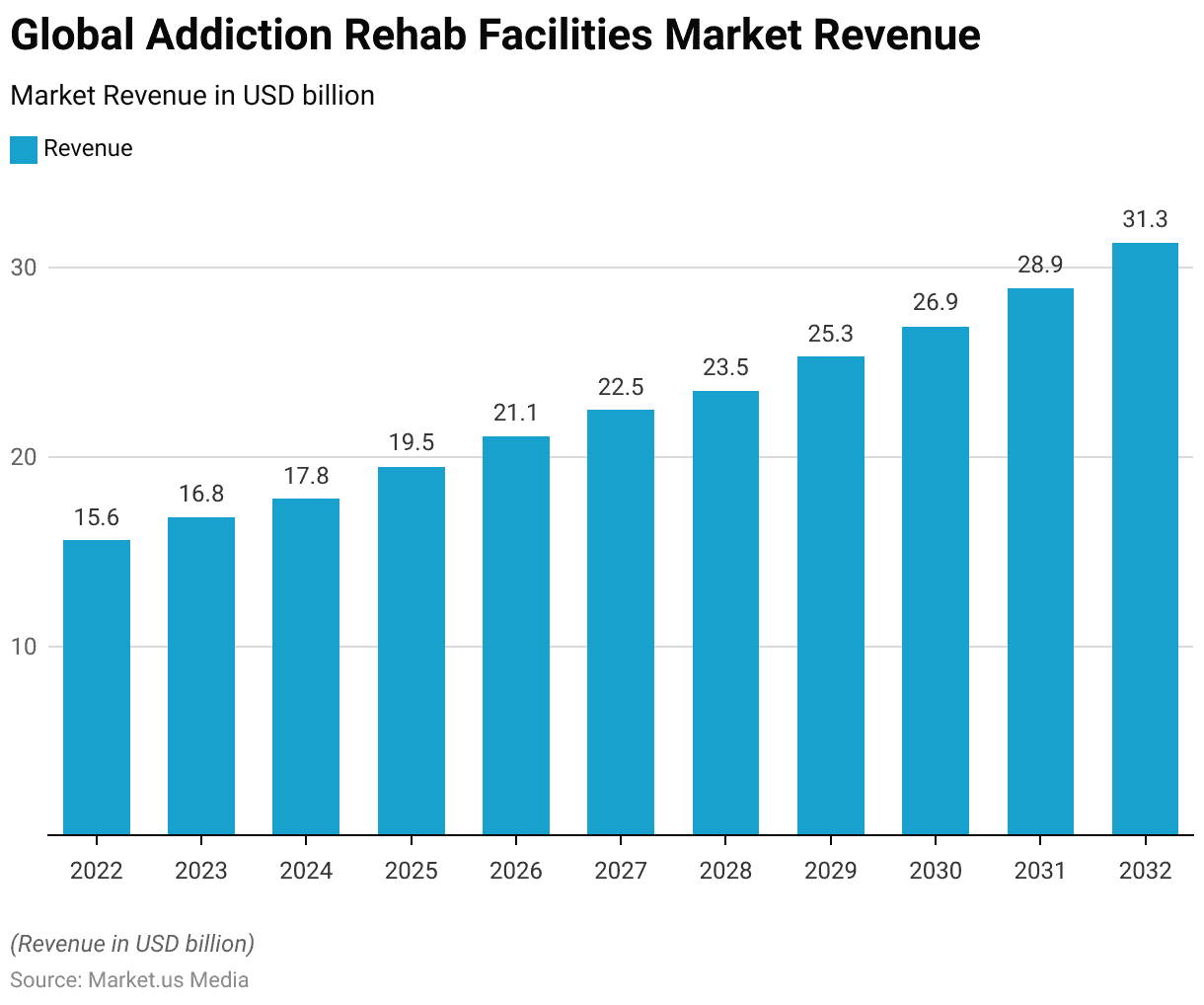
Addiction Rehab Facilities Market Size – By Treatment Type Statistics
- The global addiction rehabilitation facilities market has demonstrated steady growth from 2022 to 2032, driven by increasing demand across various treatment types.
- In 2022, the total market revenue was valued at USD 15.6 billion, with tobacco and nicotine addiction treatments contributing the largest share at USD 9.36 billion. Followed by alcohol addiction (USD 3.90 billion), opioid addiction (USD 1.25 billion), and other substance addiction (USD 1.09 billion).
- By 2023, the market expanded to USD 16.8 billion, continuing an upward trajectory with notable increases in all categories.
- Tobacco and nicotine addiction treatment revenue reached USD 10.08 billion, alcohol addiction reached USD 4.20 billion, opioid addiction generated USD 1.34 billion, and other substances accounted for USD 1.18 billion.
- This growth persisted through 2032 when the market is projected to reach USD 31.3 billion.
- Tobacco and nicotine treatments are expected to generate USD 18.78 billion, alcohol addiction treatments USD 7.83 billion, opioid addiction USD 2.50 billion, and other substances addiction USD 2.19 billion.
- This consistent expansion reflects the growing awareness and need for comprehensive addiction treatment services globally.
(Source: market.us)

Global Addiction Rehab Facilities Market Share – By Treatment Centers Statistics
- The global addiction rehabilitation facilities market is segmented by treatment center types, with rehabilitation centers holding the largest market share at 32%.
- Residential centers account for 27% of the market, while in-patient centers represent 20%.
- Other types of treatment centers occupy the remaining 21% of the market.
- This distribution highlights the dominance of rehabilitation centers within the addiction treatment sector, followed by significant contributions from residential and in-patient centers.
- These varying center types reflect the diverse approaches to treating addiction across the globe.
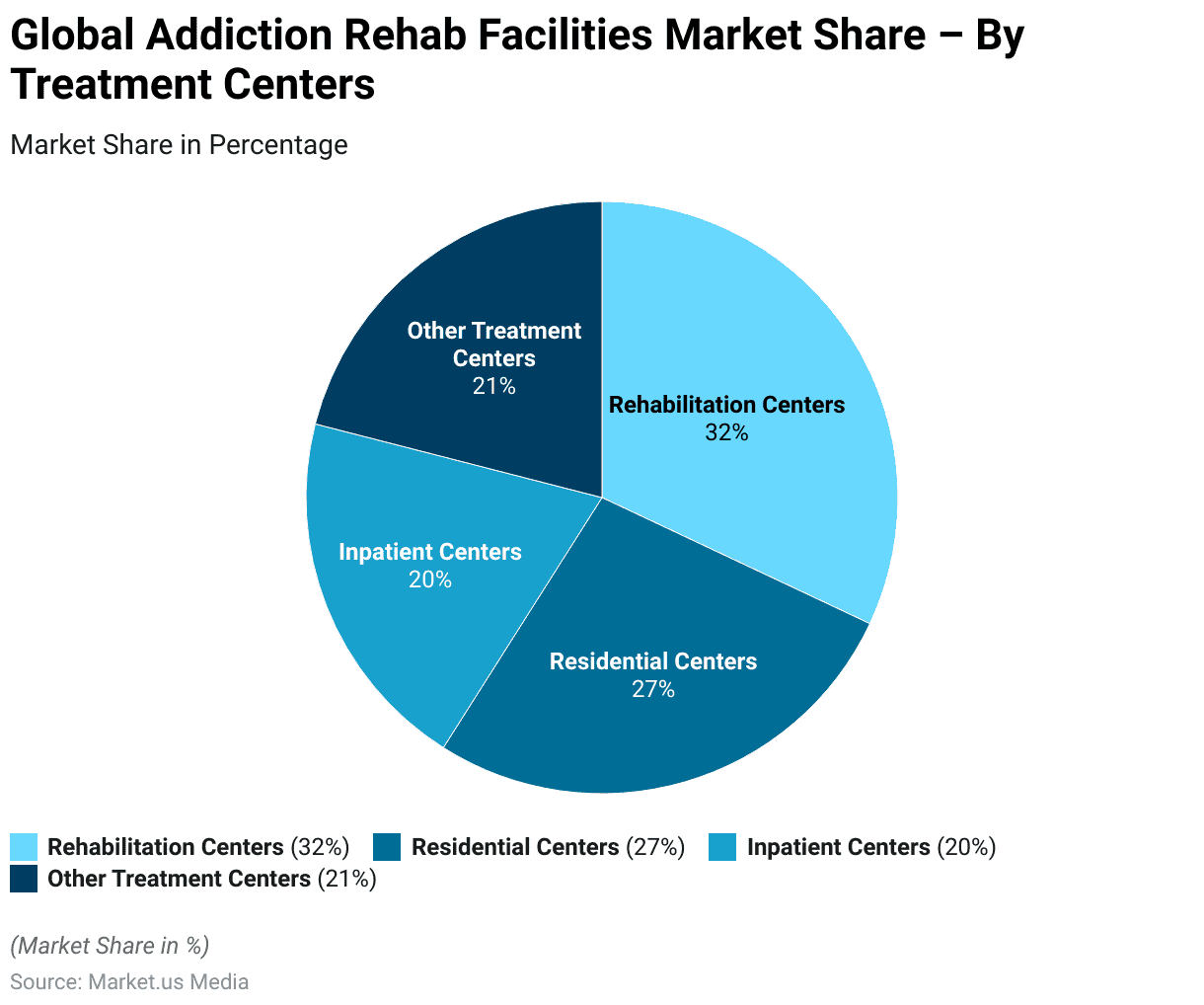
Mental Rehab Statistics
Rate of Mental Health Hospital Admissions – By Region Rehab Statistics
- In 2020, mental health hospital admissions per 100,000 population varied significantly across different regions of the world.
- Europe had the highest rate, with 275 admissions per 100,000 people, reflecting a more extensive use of mental health services.
- The Western Pacific region followed with 94.2 admissions per 100,000 population, above the global average of 71.8.
- The Americas saw 41.8 admissions per 100,000 people, while Southeast Asia had 34.5 admissions per 100,000.
- The Eastern Mediterranean region recorded 32.2 admissions per 100,000 population, and Africa had the lowest rate, with 27.8 admissions per 100,000.
- These figures highlight regional disparities in access to and utilization of mental health services across the globe.
(Source: Statista)
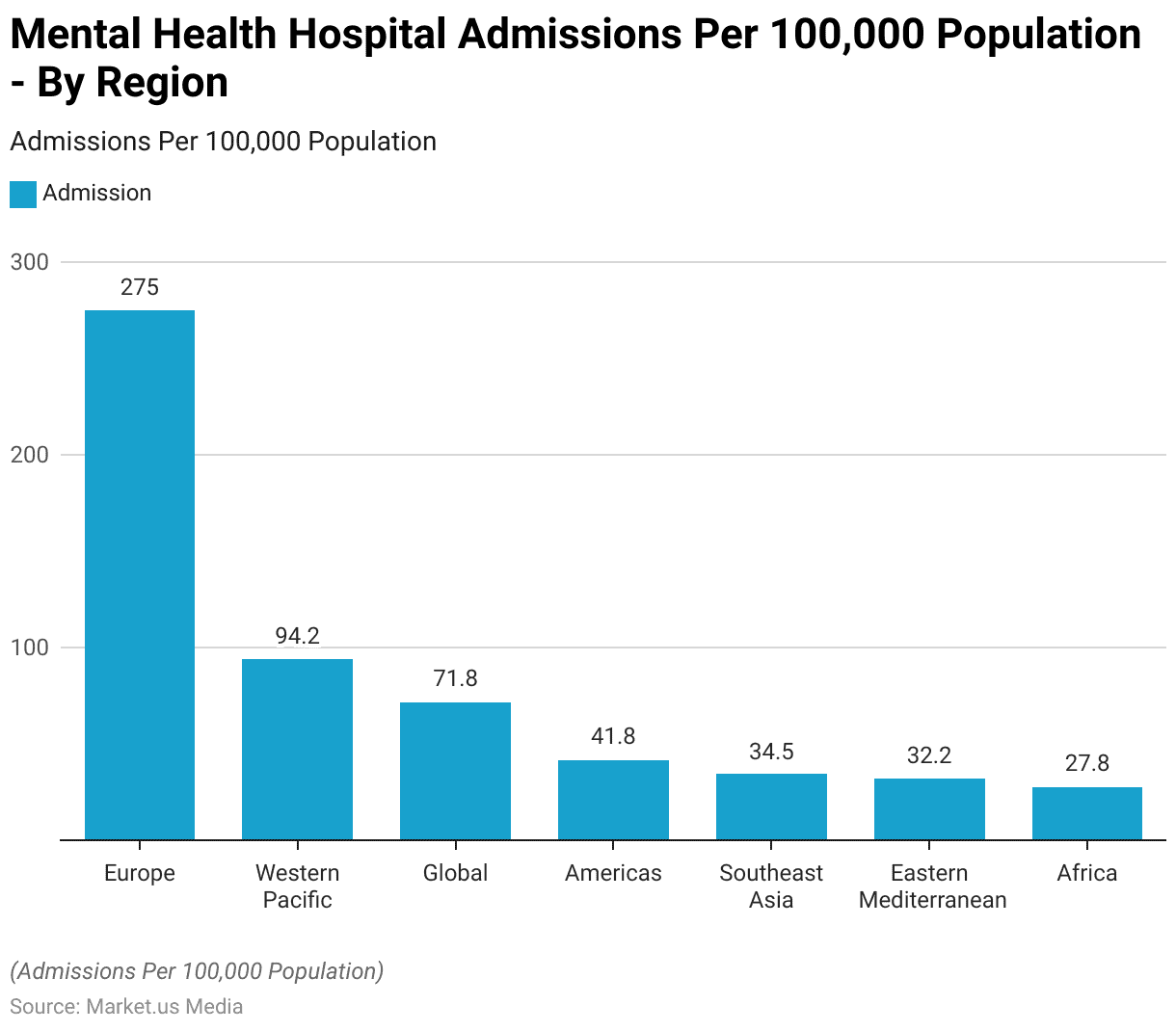
Mental Health Treatment or Counseling Among Adults By Rehab Statistics
- Between 2002 and 2022, the number of U.S. adults receiving mental health treatment or counseling steadily increased.
- In 2002, 27.2 million adults sought treatment, and by 2006, this number had risen slightly to 28.4 million.
- A more notable increase occurred in 2007 and 2008, with 29.6 million and 30.2 million individuals receiving treatment, respectively.
- The upward trend continued through 2010, reaching 31.5 million, and by 2012, 34.1 million adults were receiving mental health services.
- Between 2013 and 2017, the number of adults in treatment ranged from 34.6 million to 36.4 million.
- However, a significant rise occurred between 2018 and 2019, with the number of individuals receiving treatment jumping from 37.1 million to 40.2 million.
- This upward trajectory continued, with 41.4 million people receiving treatment in 2020 and 41.7 million in 2021.
- The most dramatic increase occurred in 2022 when the number of U.S. adults receiving mental health treatment surged to 55.8 million. Reflecting a growing demand for mental health services over the last two decades.
(Source: Statista)
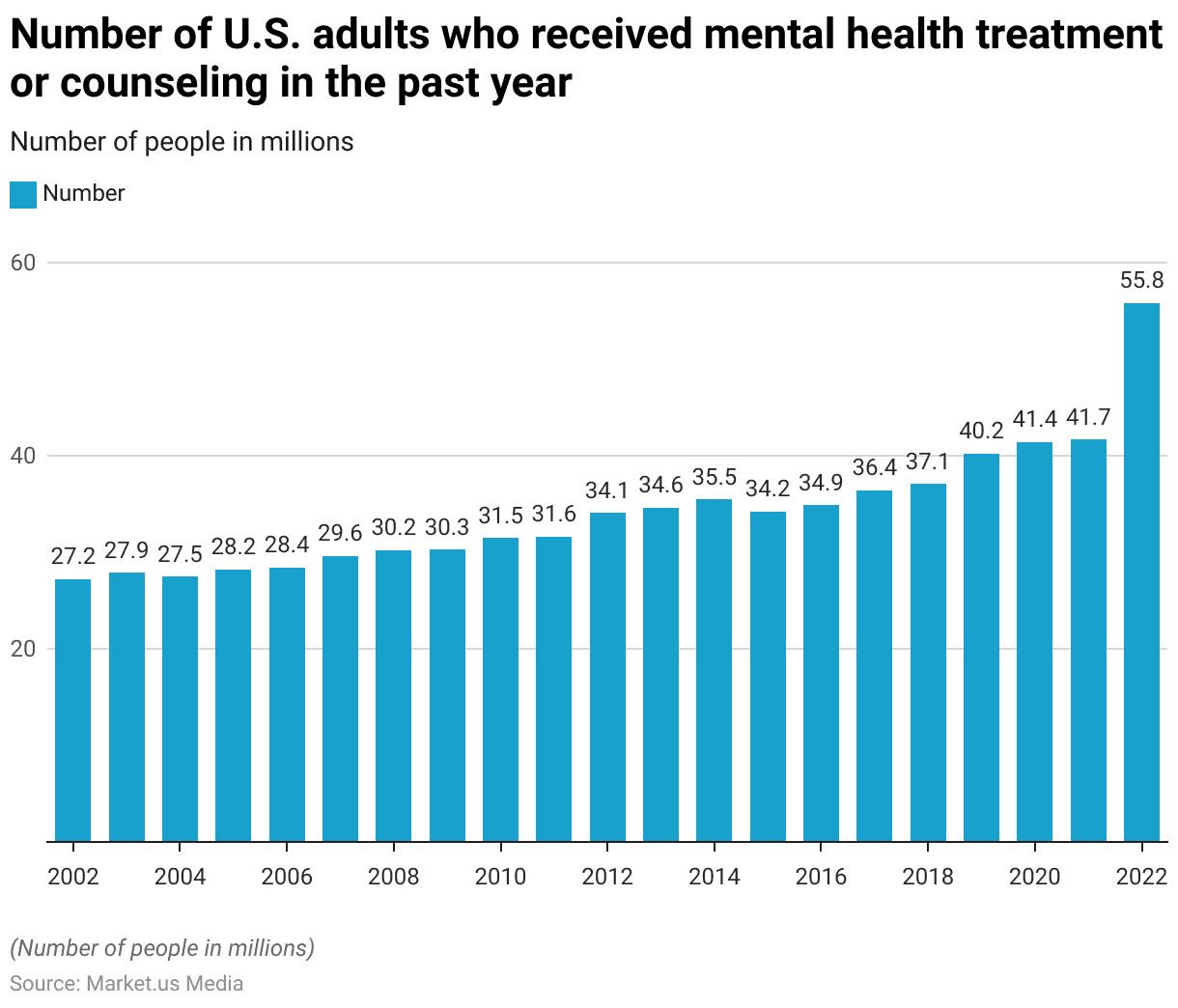
Mental Health Treatment Facilities – By Setting of Services With Rehab Statistics
- In 2022, there were a total of 11,647 mental health treatment facilities in the U.S., providing services across various settings.
- Of these, 9,586 facilities completed the survey.
- Outpatient services were the most prevalent, with 7,785 facilities offering this type of care.
- Residential mental health treatment was available at 1,713 facilities, while 1,305 facilities provided hospital in-patient services.
- This distribution reflects the diversity of mental health treatment options available to individuals across the U.S.
(Source: Statista)
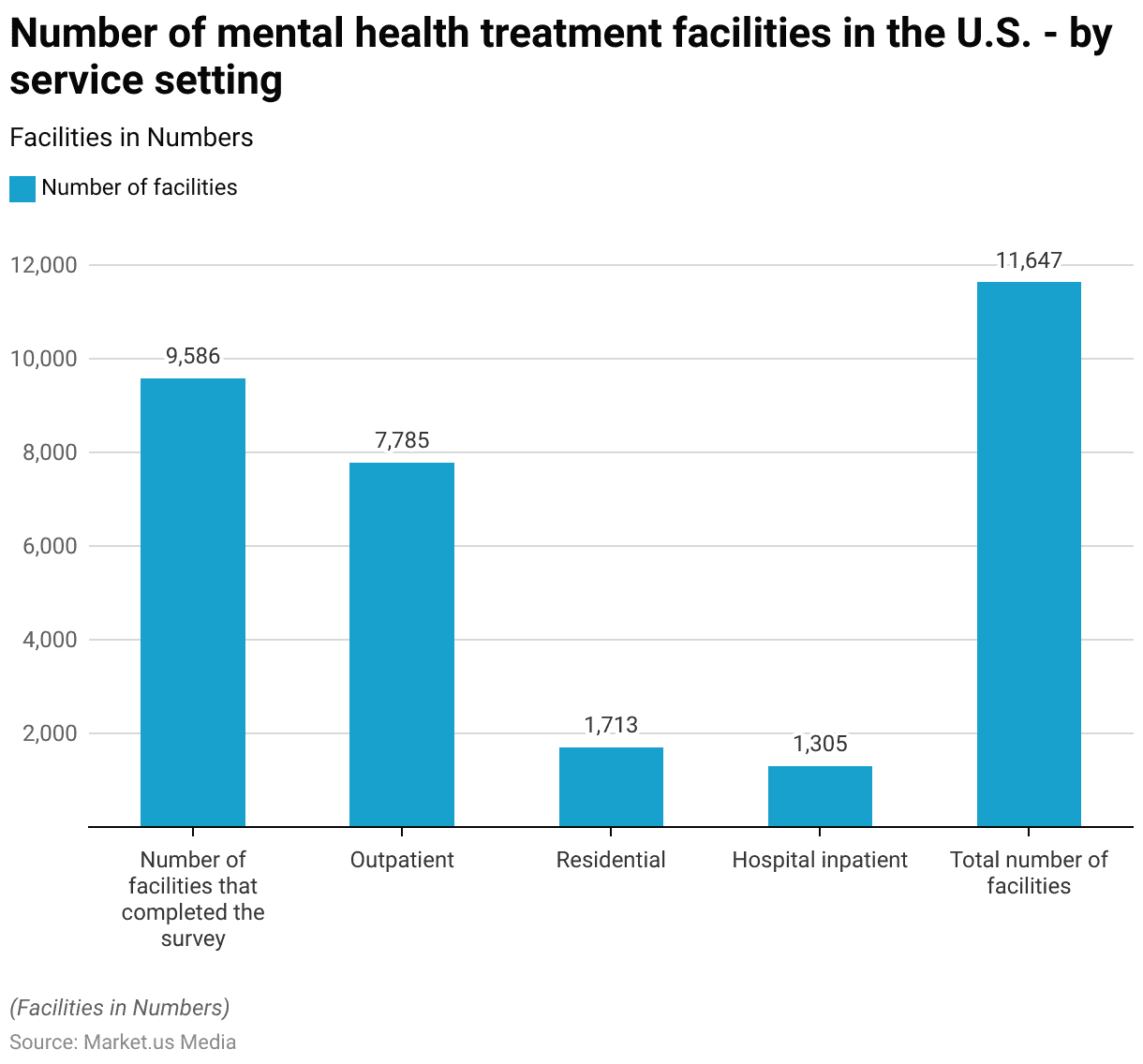
Popular Rehab Schemes Statistics
Deendayal Upadhya Rehab Scheme in India Statistics
- Between the financial year (FY) 2017 and FY 2022, the utilization of funds for the Deendayal Upadhyaya Rehabilitation Scheme in India showed notable fluctuations.
- In FY 2017, both the budget estimate and actual expenditure were aligned at 450 million Indian rupees.
- This trend of matching budget and expenditure continued through FY 2018 and FY 2019, with figures of 600 million and 700 million rupees, respectively.
- However, in FY 2020, the actual expenditure exceeded the budget estimate for the first time, with 1,020 million rupees spent against a budget of 750 million.
- In FY 2021, the budget estimate was significantly increased to 1,300 million rupees, but the actual expenditure fell short, reaching only 830 million rupees.
- Similarly, in FY 2022, while the budget estimate was 1,250 million rupees, the actual expenditure amounted to 1,010 million.
- This data reflects the variability in the alignment between allocated funds and actual spending over this period.
(Source: Statista)
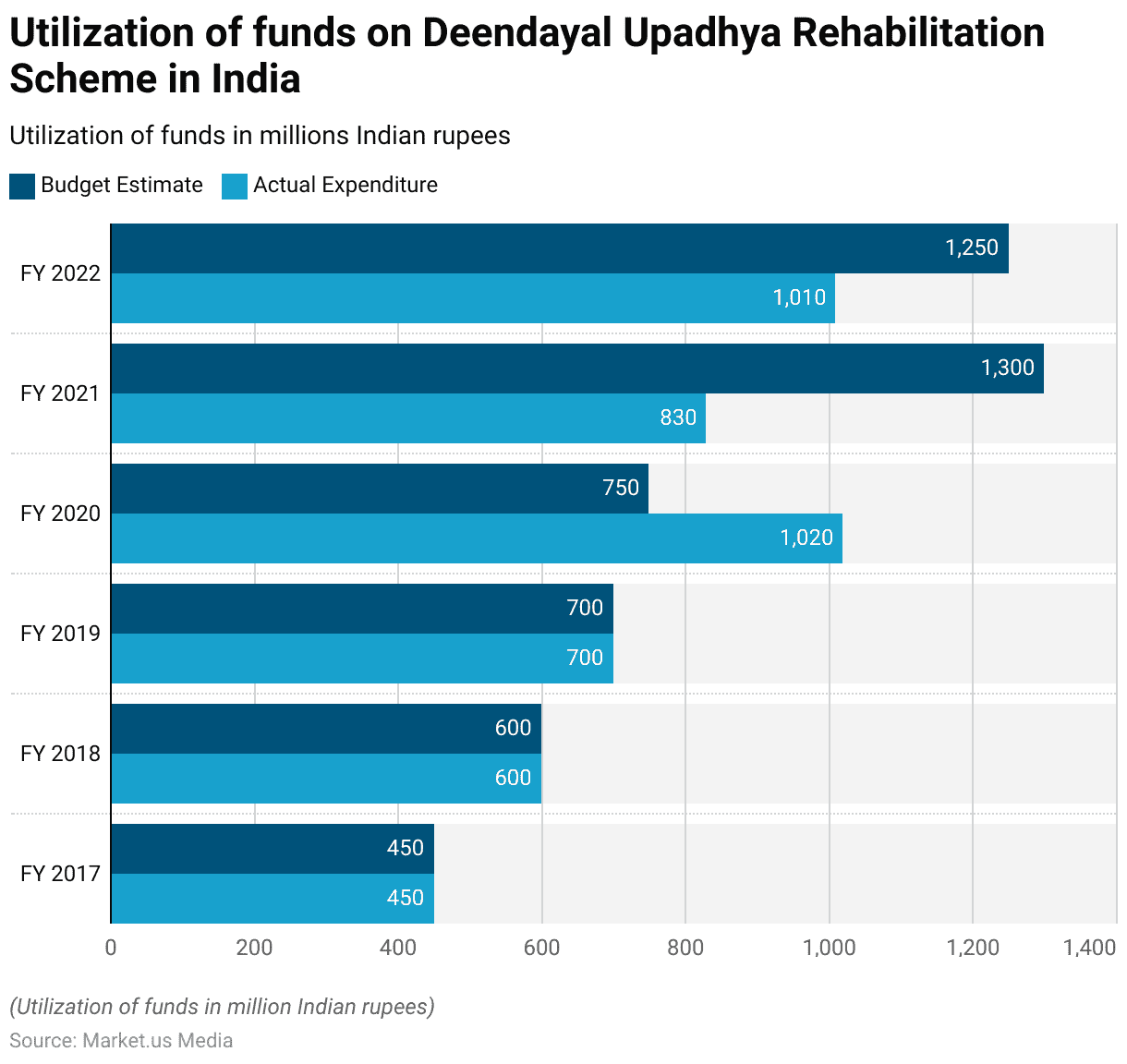
Federal Drug Control Spending in the U.S.
- From fiscal year (FY) 2012 to FY 2025, federal drug control spending in the United States has seen a steady increase.
- In FY 2012, the total spending was USD 24.5 billion, which decreased slightly to USD 23.8 billion in FY 2013.
- However, this trend reversed in FY 2014, with spending rising to USD 25.7 billion and continuing to grow gradually in subsequent years, reaching USD 28.8 billion by FY 2017.
- The most significant increases occurred from FY 2018 to FY 2023.
- In FY 2018, spending rose sharply to USD 33.3 billion and continued to increase, reaching USD 36.8 billion in FY 2019 and USD 39.7 billion in FY 2020.
- While there was a slight decrease in FY 2021, with USD 38.4 billion spent, spending surged again to USD 40.9 billion in FY 2022 and USD 44.2 billion in FY 2023.
- The enacted budget for FY 2024 stands at USD 43.6 billion, while the requested budget for FY 2025 is projected to increase to USD 44.5 billion.
- This data highlights the consistent rise in federal drug control spending over the years, reflecting the growing focus on addressing drug-related issues in the U.S.
(Source: Statista)
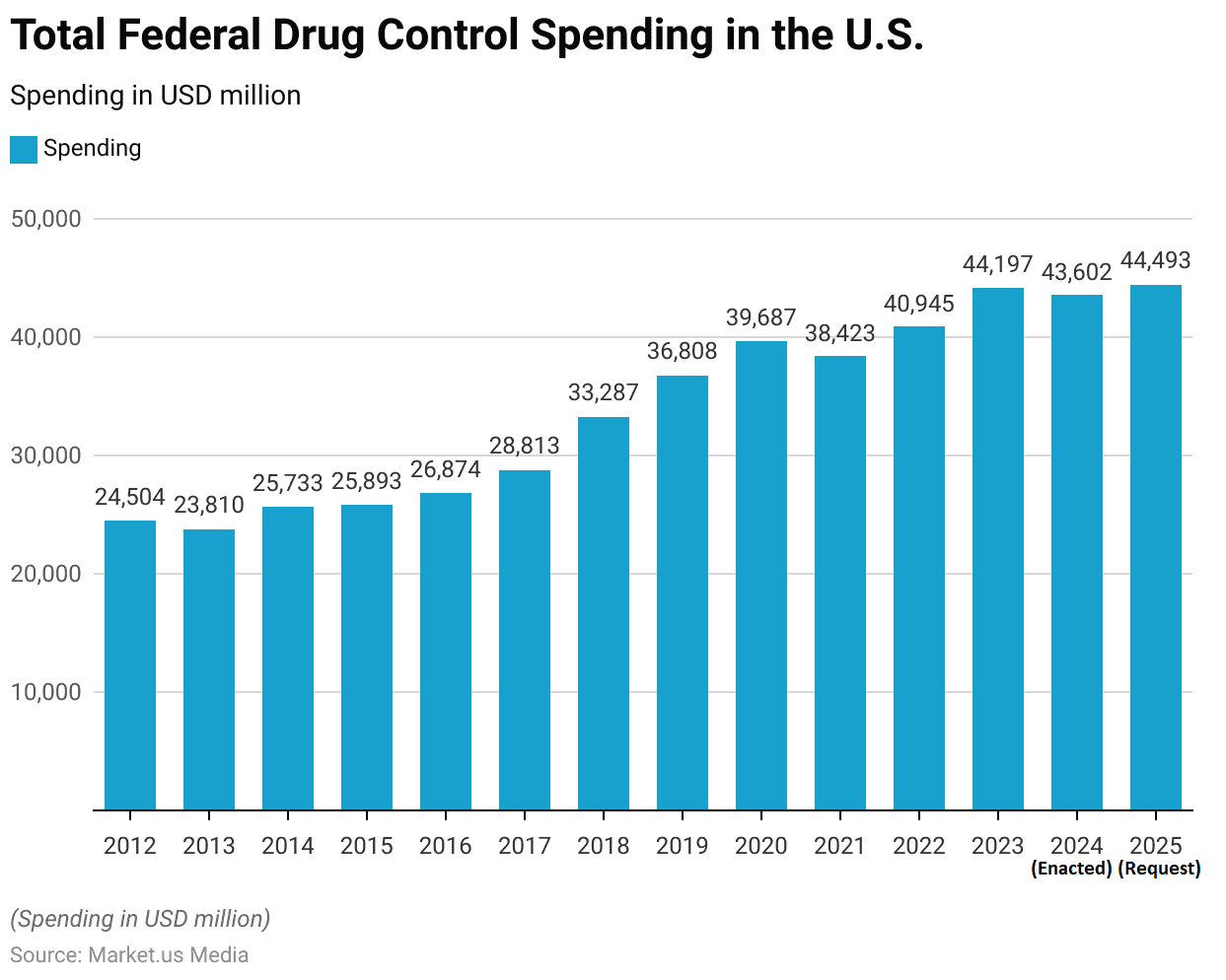
Drug Rehab Regulations and Statistics
- Drug rehab regulations vary significantly across countries, influenced by local drug policies, healthcare systems, and social attitudes.
- In the United States, the regulation of drug rehabilitation centers and opioid treatment programs (OTPs) is overseen by both federal and state governments.
- The Substance Abuse and Mental Health Services Administration (SAMHSA) sets baseline federal regulations, including rules for medications like methadone and buprenorphine, which are used to treat opioid use disorder.
- Each state can impose additional requirements, such as restricting the opening of new OTPs or mandating specific licensing procedures for these facilities.
- In contrast, countries like Thailand have shifted from punitive drug laws to more rehabilitative approaches, focusing on harm reduction and voluntary community-based treatments.
- European nations like Portugal have decriminalized drug use and emphasize rehabilitation, with services often regulated by public health agencies to ensure access to treatment without criminal consequences.
- These differences reflect broader global trends in drug policy, where some regions focus on strict legal control while others emphasize health-based interventions.
(Sources: Pew Trust, Drug Abuse, SAMHSA)
Recent Developments
Acquisitions and Mergers:
- Acadia Healthcare acquires CRC Health Group: In 2023, Acadia Healthcare, a major player in behavioral healthcare services, acquired CRC Health Group for $1.2 billion. This acquisition expanded Acadia’s rehabilitation offerings, including addiction treatment and mental health services, positioning it as a leader in the U.S. rehab market.
- Kindred Healthcare merges with RehabCare: In mid-2023, Kindred Healthcare, a leading rehabilitation services provider, merged with RehabCare, creating one of the largest post-acute care providers in the U.S. The deal, valued at $700 million, aims to enhance Kindred’s rehab services in hospitals and skilled nursing facilities.
New Product Launches:
- NeuroGym launches rehab equipment for stroke recovery: In early 2024, NeuroGym Technologies launched a new line of advanced rehab equipment designed for stroke recovery patients. These products feature AI-driven motion tracking to help patients regain mobility faster through personalized exercise programs.
- Pear Therapeutics launches reSET-O: In 2023, Pear Therapeutics introduced reSET-O, a digital therapeutic app aimed at helping patients recover from opioid addiction. The app offers behavioral therapy and progress tracking, marking a shift towards tech-based rehab solutions.
Funding:
- CleanSlate raises $75 million in Series D funding: In 2023, CleanSlate, a provider of outpatient addiction treatment, secured $75 million in funding to expand its services across the U.S. The company plans to use the funds to open new clinics and enhance its digital treatment options.
- Ria Health secures $50 million for alcohol rehab tech: Ria Health, a tech-driven alcohol rehab provider, raised $50 million in 2024 to expand its telemedicine and digital treatment services. The funding will be used to improve virtual care options for patients seeking recovery from alcohol addiction.
Technological Advancements:
- AI and Virtual Reality in Rehab: AI and virtual reality (VR) are revolutionizing rehabilitation, particularly in physical therapy and addiction recovery. By 2025, over 35% of rehab centers are expected to incorporate AI-driven tools or VR programs to enhance treatment effectiveness, providing personalized therapy plans and immersive treatment experiences.
- Telehealth Rehab Services: Telehealth is rapidly gaining popularity in rehab, especially for addiction recovery and mental health treatment. In 2023, 40% of rehab facilities offered telehealth services, and this number is expected to increase as remote care becomes more widely accepted.
Market Dynamics:
- Growth in the Rehab Market: This growth is fueled by rising demand for addiction recovery services, mental health treatment, and advancements in physical rehabilitation technologies.
- Rising Demand for Tech-Driven Rehab Solutions: The growing adoption of digital health and tech-driven rehab services is a significant trend. By 2025, 30% of rehab services are expected to integrate digital platforms, including telemedicine and mobile apps, to provide more accessible and personalized care.
Conclusion
Rehab Statistics – Rehabilitation centers are essential in addressing the rising global need for substance abuse and mental health treatment.
With growing addiction rates and increased awareness, the a demand for diverse treatment options. Including outpatient, residential, and in-patient care, continues to expand.
As global investment and public focus on recovery increase, the rehabilitation market is projected to grow significantly.
Enhanced accessibility and quality of care are key to helping individuals overcome addiction and reintegrate into society. Making rehabilitation services a critical component of public health efforts worldwide.
FAQs
Rehabilitation is a structured program designed to help individuals overcome substance abuse or mental health disorders. It typically involves therapy, medical treatment, and support services to promote recovery and reintegration into society.
Rehabilitation programs vary and can include outpatient care, and residential treatment. In-patient hospital care, and other specialized services tailored to individual needs.
The length of rehab treatment depends on the individual’s condition and the type of program. It can range from 30 days for short-term programs to several months or even longer for long-term or residential care.
Many rehabilitation programs are covered by health insurance, including Medicaid, Medicare, and private insurance plans. Coverage details depend on the insurance provider and the specific treatment.
Rehabilitation can be highly effective, especially when combined with ongoing support and aftercare. Success depends on several factors, including the individual’s commitment, the quality of care, and post-rehab support.
Discuss your needs with our analyst
Please share your requirements with more details so our analyst can check if they can solve your problem(s)



